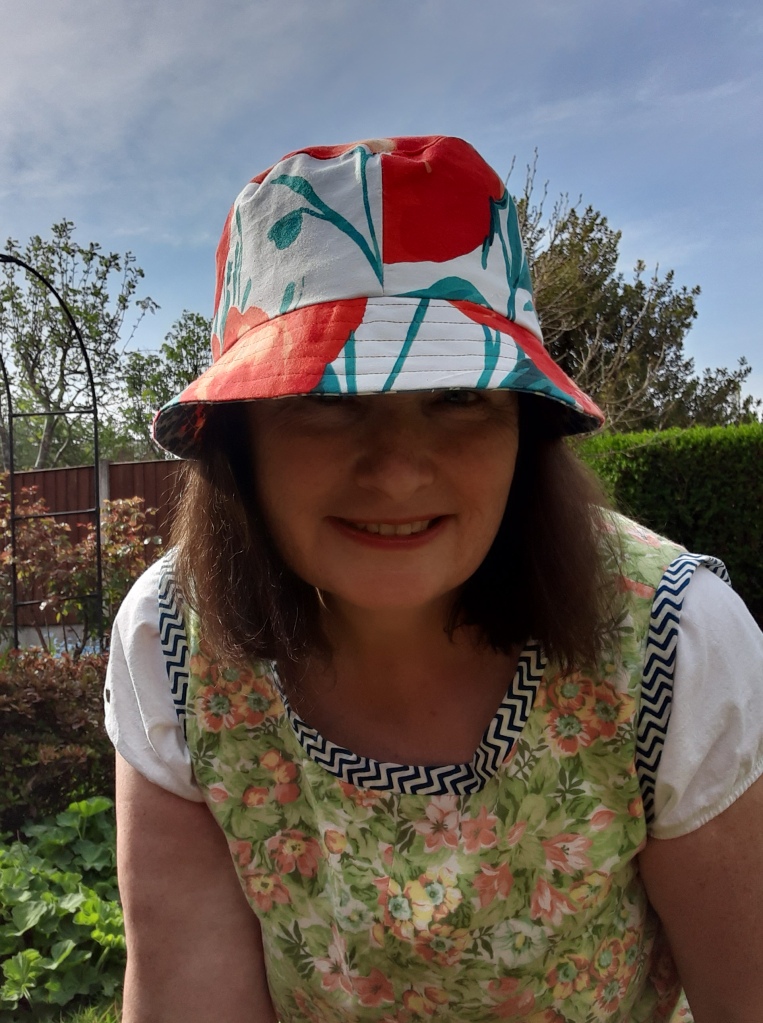Latest Event Updates
2022 Sewing review
Yes, I do mean 2022, I’m a bit behind.
I made 10 things
M8030 shirt dress in striped quilting cotton

Why did I make this dress? I was going to a party and wanted a new dress to wear, pattern was already in my stash given free with Love Sewing magazine.
The fabric suggestions revealed it was designed for striped fabrics which narrowed the choice down a bit. I had 2m of striped quilting type cotton, bought from a bulk charity shop purchase, a fabric which hadn’t really been on my radar.
Sewing with quilting cotton is such a dream and it worked well with this pattern. Fabric requirements were 2.7m to my 2m but by shortening the length, making the button placket from pieces, and using a scrap of another fabric for the pockets, it all came together. I shortened the length of the yolk by 2cm following a suggestion by another blogger to make the armholes smaller, and the main pieces by 4cm but it’s still a bit long on me.
I made a M at the shoulders and L elsewhere and its quite roomy. I’ve worn this dress 22 times at the time of writing and it still counts as a casual going out dress. It’s a comfortable dress and I always like wearing it but when I see photos of me in it, it doesn’t look very flattering. I like this pattern and would consider making again. I think this one has at least another 30 wears in it.
Replacement rucksack
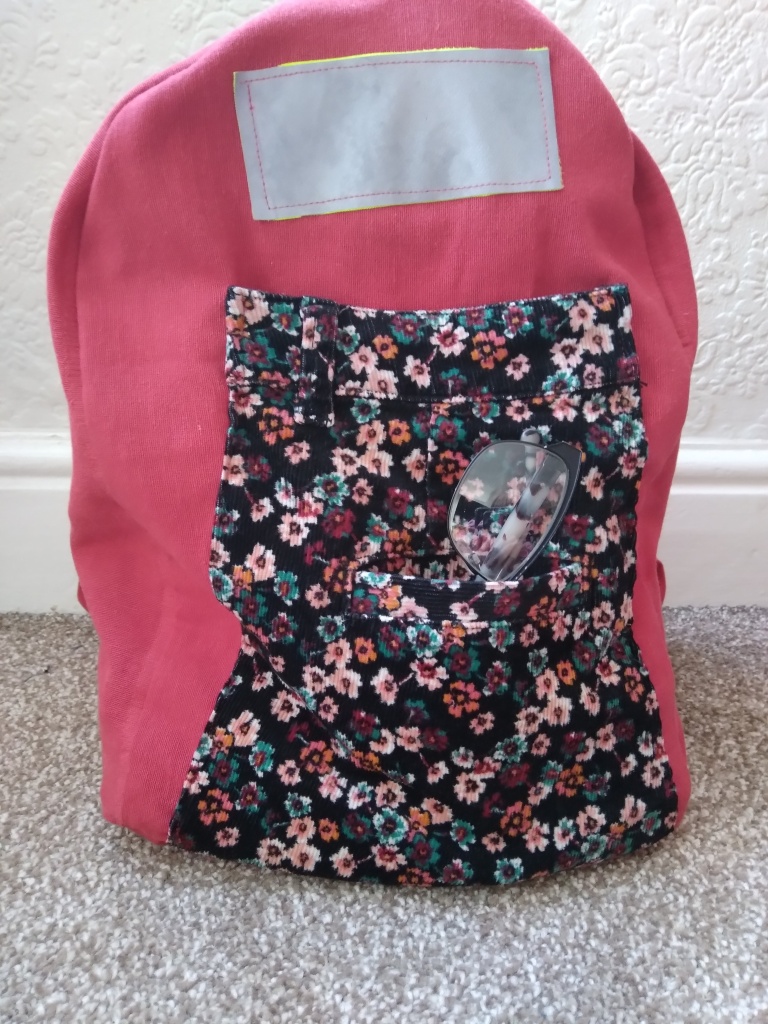
I made a 2nd version of a rubbed off rucksack basically using fabric scraps. This is probably my most worn make of the year as I use it daily. I like the front pocket which is the back of a pair of shorts and includes the shorts pocket and belt hooks. 2023 update – this rucksack wore out and I’ve now made another one. Making rucksacks is great because you can use up a load of small pieces.
2 x T shirts from own block
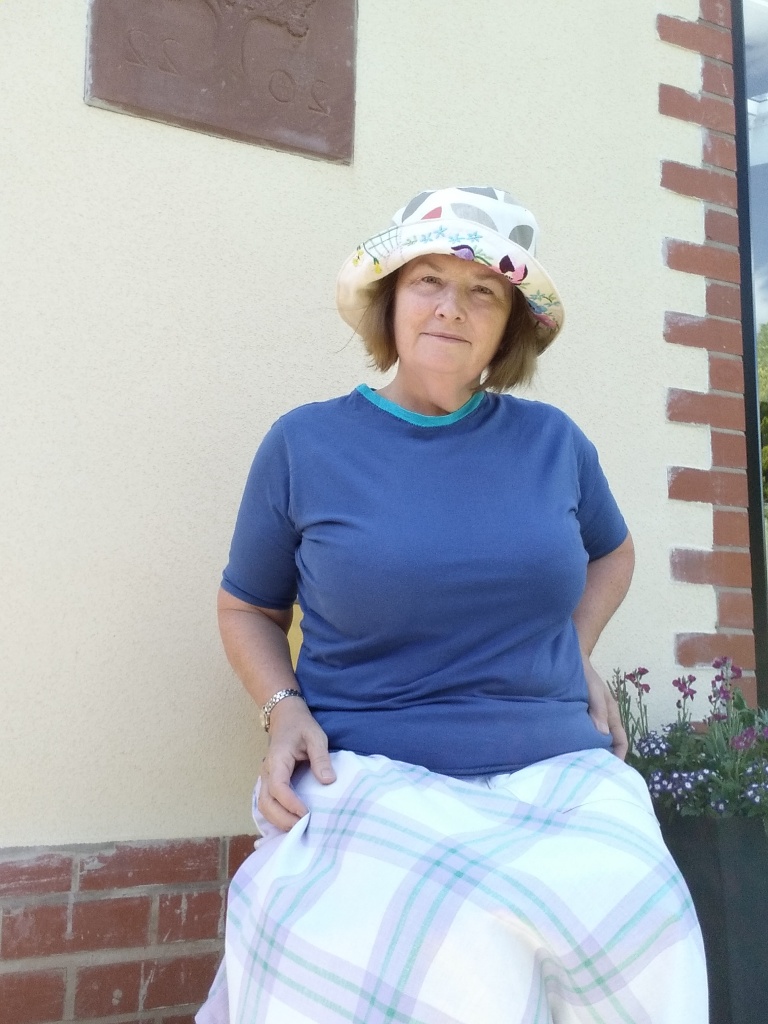
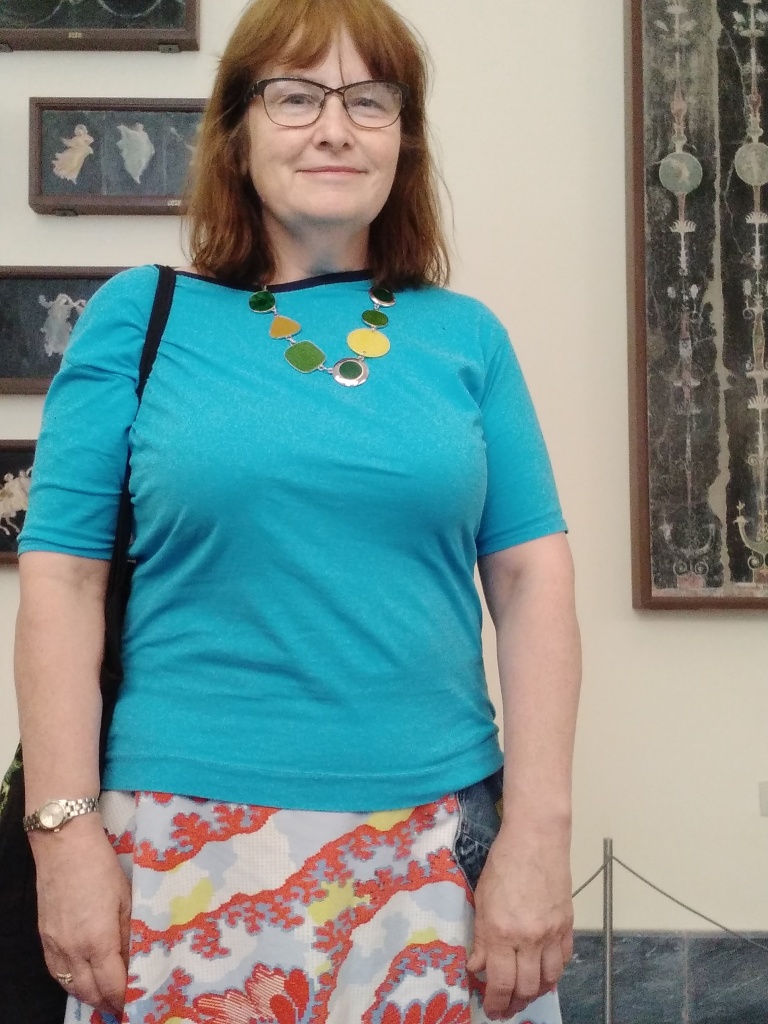
Why did I make these t-shirts? They were experimental and I wanted to try out something I’d read about.
I was inspired by Sewing with Di to create my own block and use the block to sew up a couple of t-shirts. The reason her post caught my eye was because she points out the importance of vertical measurements as well as horizontal ones, which makes such sense because it’s great to know your waist measurement but important to place the measurement in the correct vertical place. I took lot of body measurements, vertical as well as horizontal, and drew a block and used it for a basic t-shirt. I didn’t use my actual waist measurement because t-shirts aren’t shaped at the waist that much, and my sleeve ended up without much of a sleeve head on the first version. I made a kind of boob bulge in the side seam because all t-shirts end up with drag lines towards the bust apex with me. The bulge probably only added about an inch of ease – the armhole got in the way of doing it properly, but maybe the bulge made a bit of difference.
I used low quality t-shirt fabric bought in a charity shop and did not add a seam allowance, counting on the 35% widthways stretch in the fabric for ease.
For the 2nd version I raised the sleeve head, shortened and widened the sleeve, and lowered the neckline a little.
Both versions are close fitting t-shirts which have been worn 20 times each. Next time I make a t-shirt I’ll use an actual pattern but reference this block.
Due to the poor quality fabric and close fit I don’t see these t-shirts lasting beyond 40 wears, if that.
Sewgirl Amelia top in Liberty lawn

Why did I make this? Just got the urge to sew something. I’d bought this 1 metre of Liberty tana lawn a few years ago in the London shop. Once again I already had the pattern given free in a magazine. The style is very simple and I made a size 14 but in the unlikely event of making it again I would size down to a 12 as it came out big and shapeless. I added a shoulder dart and took in the sides. The lovely fabric rescued this garment, which has been worn 20 times, but due to the lightness of the fabric it’s a summer season only top. I don’t buy these magazines any more because after a while they don’t seem fresh but I do often buy the patterns that came with them if I spot them in a charity shop.
Half circle skirt
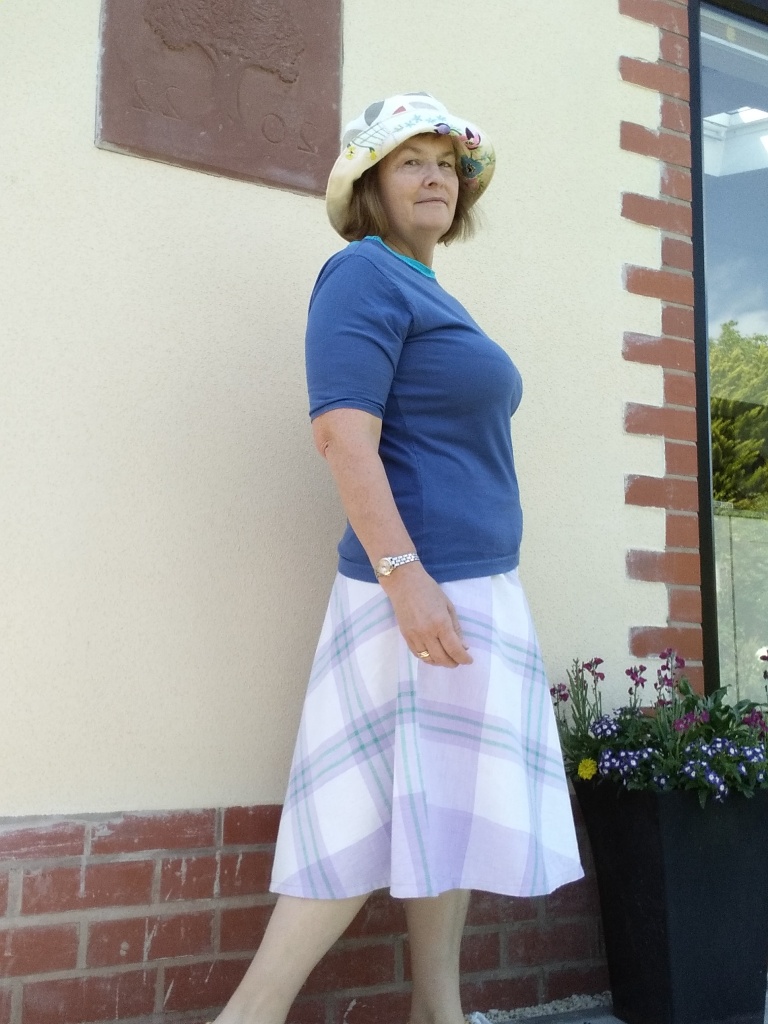
Why did I make this? I wanted to make something and didn’t have that many skirts. I looked through my patterns and found this half circle skirt included as an option. It was a chance to repurpose one of the growing number of tablecloths I’ve purchased.
Just about managed to eke this out of a linen tablecloth with just a small join in the back piece. I added a pattern matched patch pocket. It’s a basic make I’ve worn 20 times and fits well into my wardrobe. My waist was larger than the largest size but I just made a waistband to fit me and added a little to the top edges of the skirt. I repeated a mistake I have made before which was not letting the skirt hang before hemming it.
Update – the tablecloth was a fairly loose weave and I’ve had to repair a small tear at the pocket opening. I don’t think this skirt will see 50 wears.
K8878 Shift dress from Ora Keily Curtain.
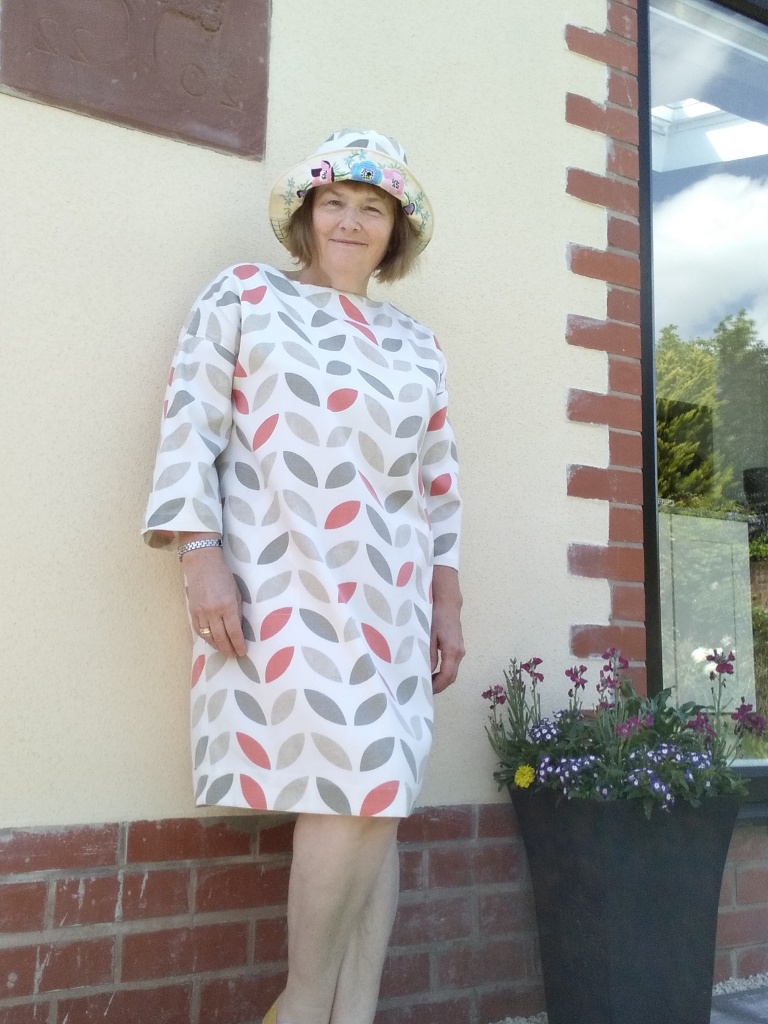
Why did I make this? – wanted something new to wear on holiday.
I made the most basic version of this dress, which can also be made as a tunic, using fabric which was formerly a curtain. The curtain fabric was medium weight which worked well for this dress but it was fairly loose weave and frayed like hell. I made a size M at the shoulders and L elsewhere, and if I make it again would size down the sleeves and neckline. The pocket construction was a bit different because the pocket doesn’t hang free but is sewn onto the front piece. I like this dress a lot and have another curtain in mind to make another from, trouble is I already have too many dresses.
The dress is very comfy and has been worn 20 times up to now but because the fabric frays so much, has a few pulls, and has faded a bit, I can’t see it lasting beyond 40 wears.
K9041 Simplicity
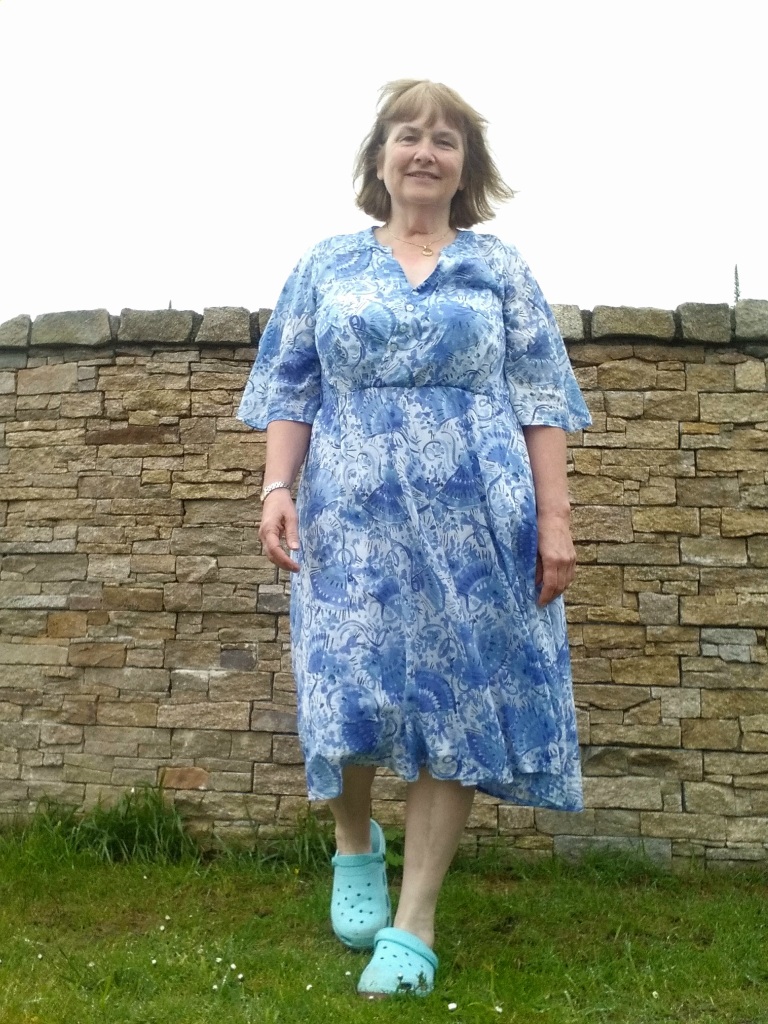
Why did I make this? – for a holiday, pattern was given free in a magazine.
I made this dress for a holiday in vintage 1981 fabric which is very light and floaty. I made a size 14 throughout with a FBA which took the form of an increased bodice width. The wrap element inevitably gaped so I closed it with some buttons which does spoil the look a little, but I still feel very glamorous in this dress. The fabric is a little see through so I wear it with an underskirt.
Due to the delicate nature of the fabric this dress is still a ‘going out’ outfit and I have only worn it 10 times but unless it gets damaged I can see the dress going to at least 40 wears.
2 x Blackwood cardigans
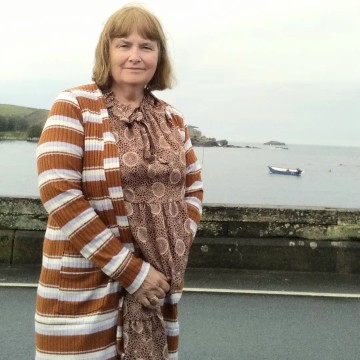
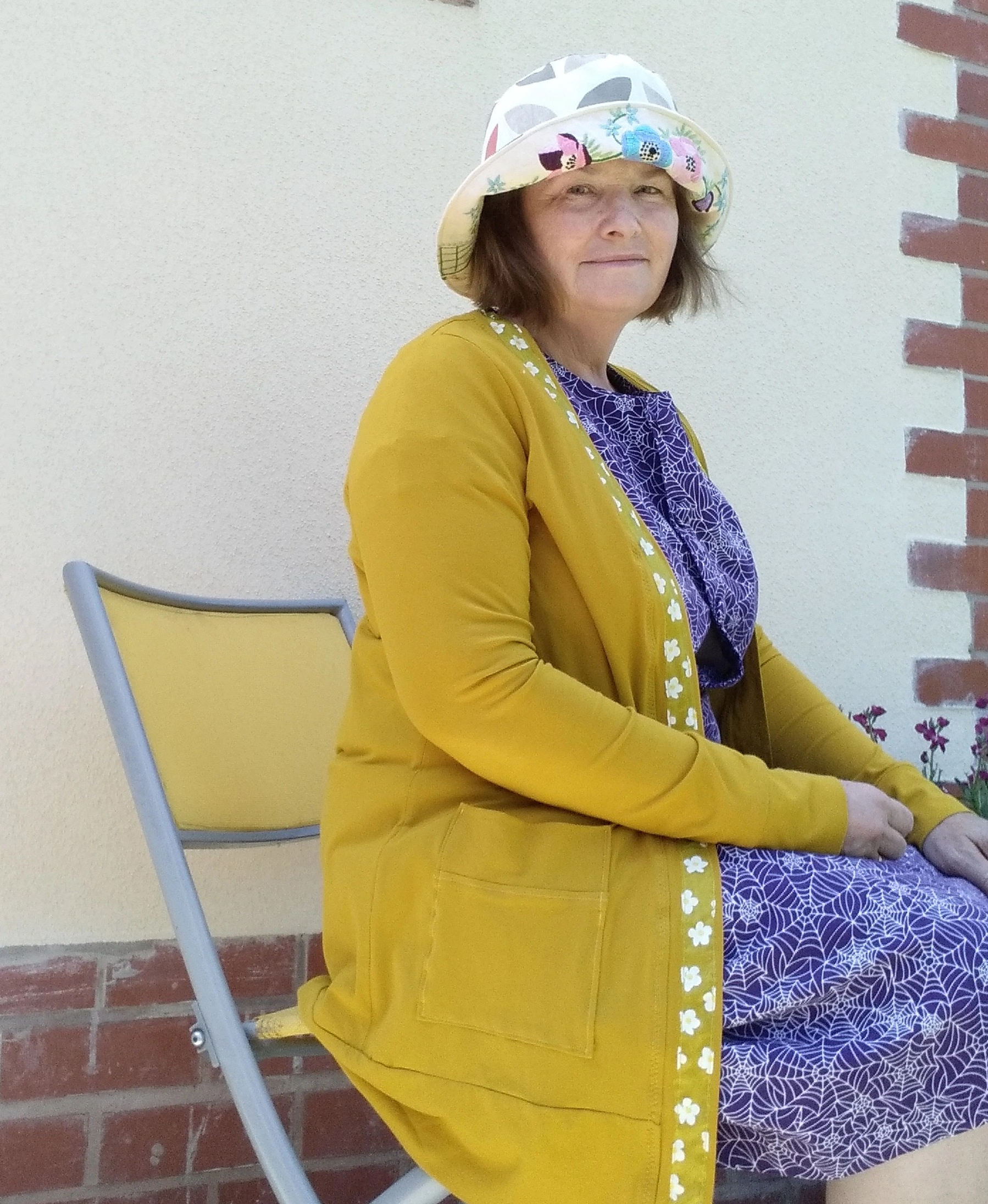
Why did I make these? Both fabrics I used were bought new in a shop (unusual for me) and I also bought the pattern in 2021. I always know Helen’s closet patterns will turn out well.
The first version was in a lightweight rib knit and was the longer length cardigan. It came together very easily and I soon got started on the 2nd version. The fabric for the 2nd one was mustard coloured viscose jersey, in a nice quality which I’d originally purchased to make a t-shirt as a gift. It came out equally well as a Blackwood cardigan. I’m not sure if I am completely happy with the non-closing design of this garment as I find myself constantly pulling it together at the front, but it isn’t meant to close, however both of these cardigans have been versatile and well worn. I don’t count how many times I wear them as they are taken on and off during the day.
Conclusion – In 2022 I made 10 items to wear, and also discarded 13 items because they were worn out, in line with my goal to reduce the number of clothes I have until everything can be worn at least 10 times per year. The reason (or excuse I use) to make something new is for a particular occasion like a holiday, not because of actual need, and here lies the dilemma, I want to sew but I want to wear my clothes out within a reasonable time frame, and I am finding most items can easily take 40 wears. I have found that good fabric is the most important element in the success of a make and can rescue a mediocre pattern.
A note on washing and #30 wears – I read an article, the gist of which was if you can’t commit to wearing a garment 30 times, don’t buy it. My records have shown that almost everything can make it past 30 wears, but will be showing some signs of age by then. I don’t always wear my clothes all day long because I have 2 jobs which require a uniform. I also don’t wash my clothes that often, usually only after about 5 wears, and I consider that washing something is the equivalent of about 5 wears, so maybe that’s why my clothes are lasting a long time. I am a professional gardener and my gardening clothes get washed 20 or 30 times per season. They do not last beyond one or two seasons.
Due to the lateness of this post it’s now nearly time to write the 2023 version. I’ve only made 6 things in 2023 so not that much to write about.
Sew where are they now? 2018 edition
In 2018 I was still a relatively new sewist happily sewing and refashioning away without a care in the world. I made quite a lot, what happened to it all? Since 11th Oct 2019 I have been keeping records of what I wear so I do have more information to include in this post. I should point out that I wear all of my makes in a kind of rotation. The way it works is that I have 4 outfits on the go at any one time and once I have worn something 10 times, it gets put away until it’s the garments next turn. My aim is that everything should get worn at least 10 times per year. My system is flexible to accommodate holidays and seasons but one important thing I have noticed is that familiarity does not breed contempt. What I mean by this is that often clothes that I’ve worn 10 times become ones which I am reluctant to put away, even if I wasn’t particularly looking forward to their time in rotation.
This post doesn’t include everything I made in 2018, but it’s a large sample.
Two t-shirt refashions
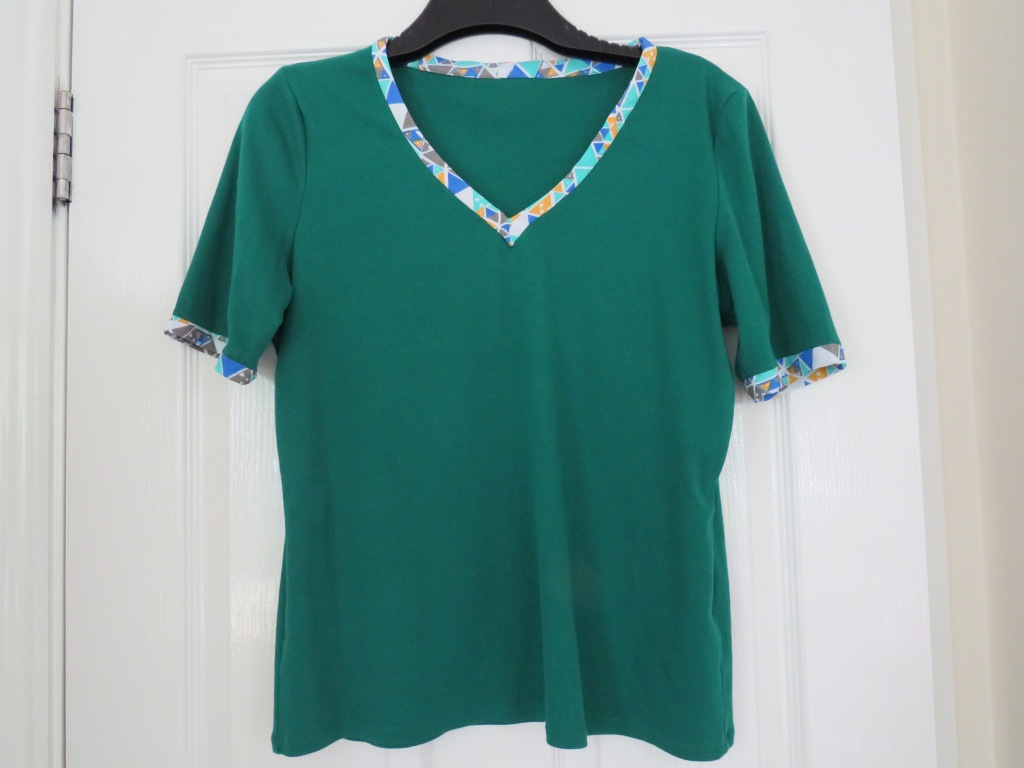
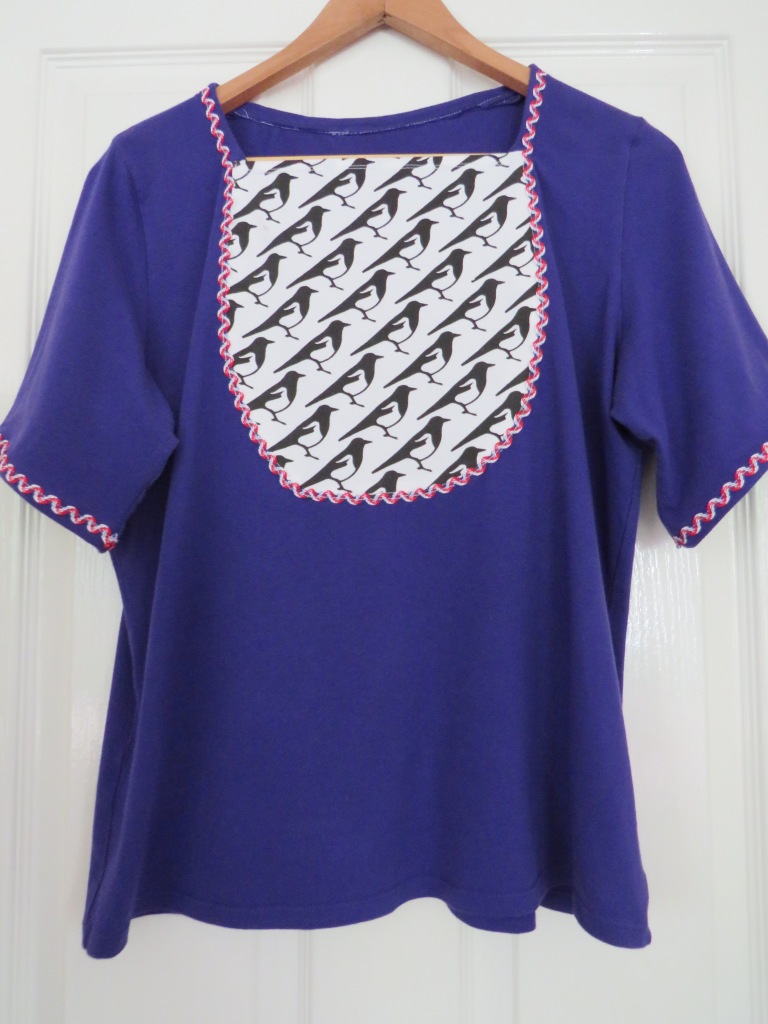
I bought 2 large, lightly worn plain t-shirts at a car boot sale for £1 each, with the intention of adding some extra trims and treatments copied from things I’d seen on pinterest.
The green one was given a simple treatment of bias binding around the cuffs and neckline. It had 10 recorded wears and probably another 20 or so before I started my records, and was discarded in May 2020. Reasons for it getting thrown out were wear and fraying of the fabric I had added, and armpit stains.
The purple one was given a more elaborate neckline of a fabric bib trimmed with rick rack. This one is still in my wardrobe and has had 30 recorded wears and probably another 20 before that. I’ll be throwing it out after the next 10 wears as I’ve had enough of it.
Skirt and trousers made from the same tablecloth
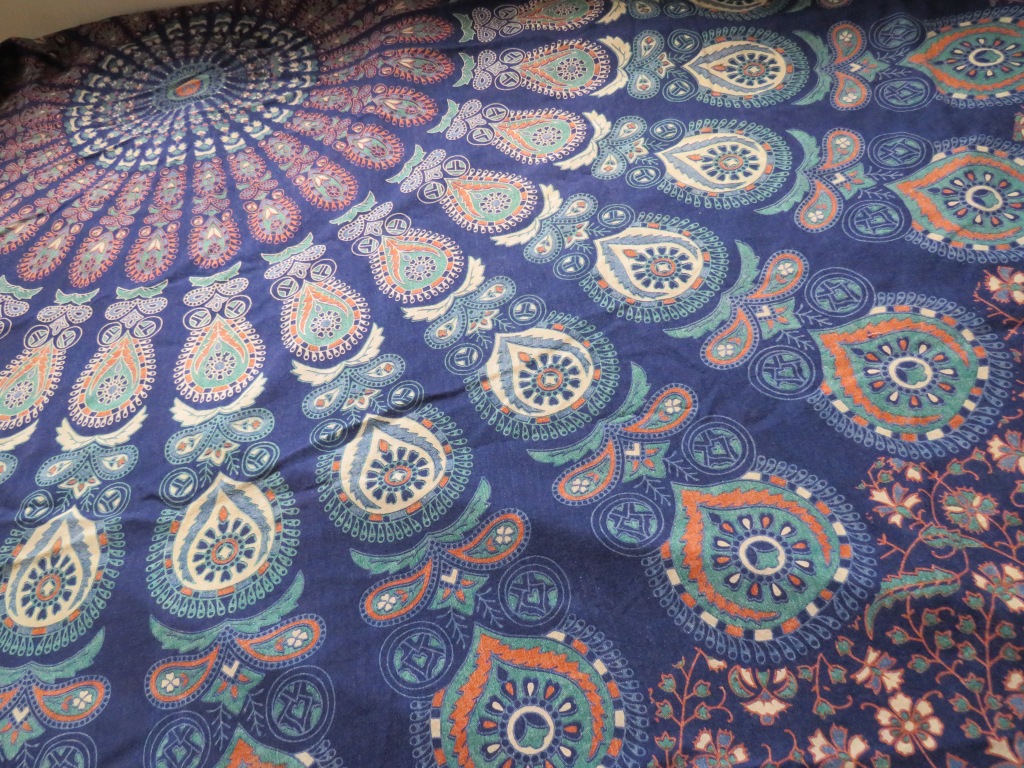
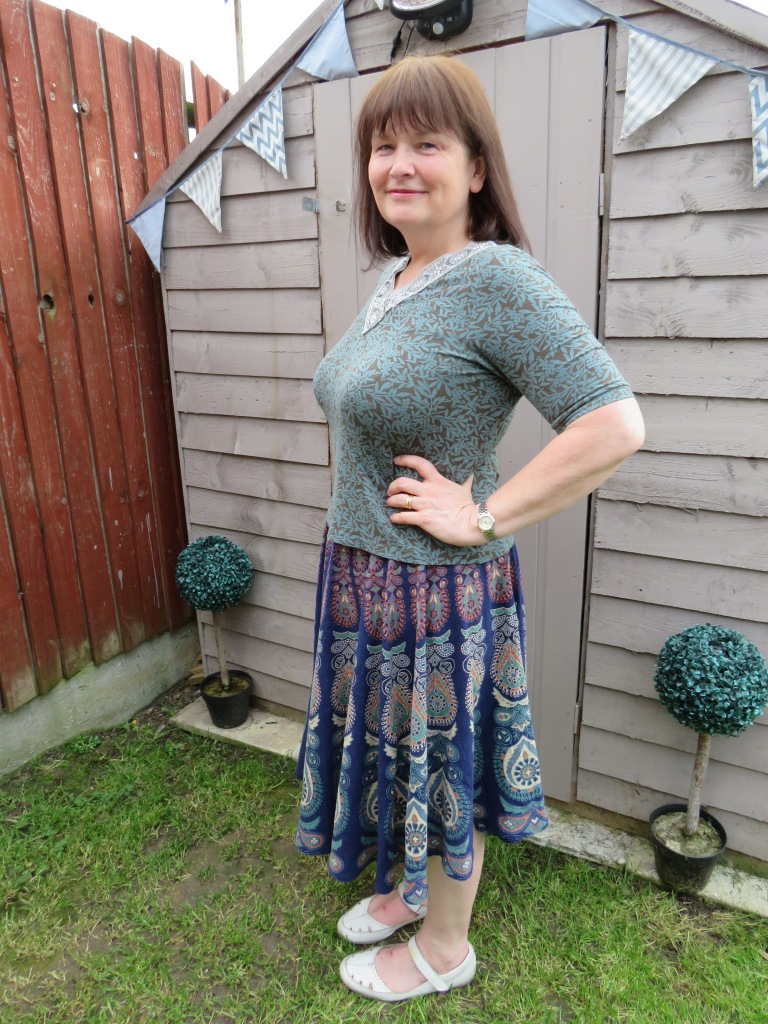
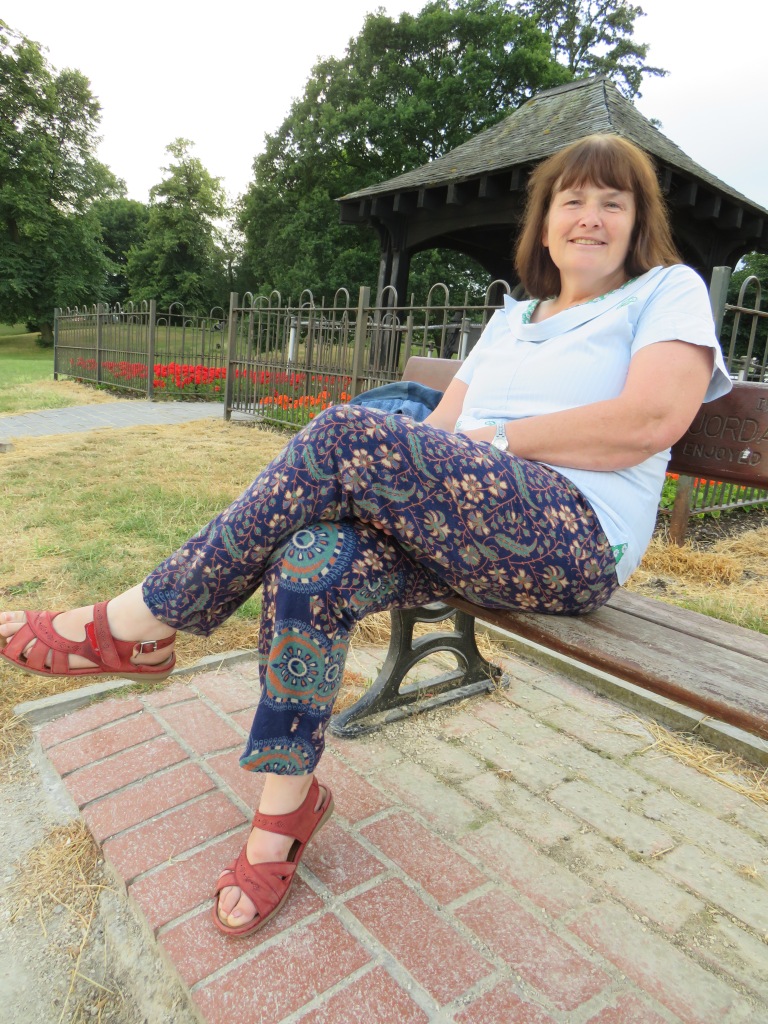
I bought a tablecloth in Oxfam for what I considered at the time to be a pricey £15. It’s a fairly common piece, a large circular print in the centre in some kind of loose woven batik type print.
I immediately thought ‘circle skirt’ as the cutting out would be easy but in fact, but this resulted in a skirt with an uneven hemline as bias cut skirts need to be left to hang before hemming. Nevertheless this got 20 recorded wears before it was discarded in June 21. Reasons for discarding it were fading of the print and it also had a rip in it.
I had sufficient fabric to make trousers from the edges of the tablecloth and they got 30 recorded wears, being discarded from my rotation in April 2021, for the same reasons as I discarded the skirt, however, the trousers lived on as gardening wear, probably getting an extra 20 wears before I replaced them with some pants with pockets.
Table runner and denim trousers
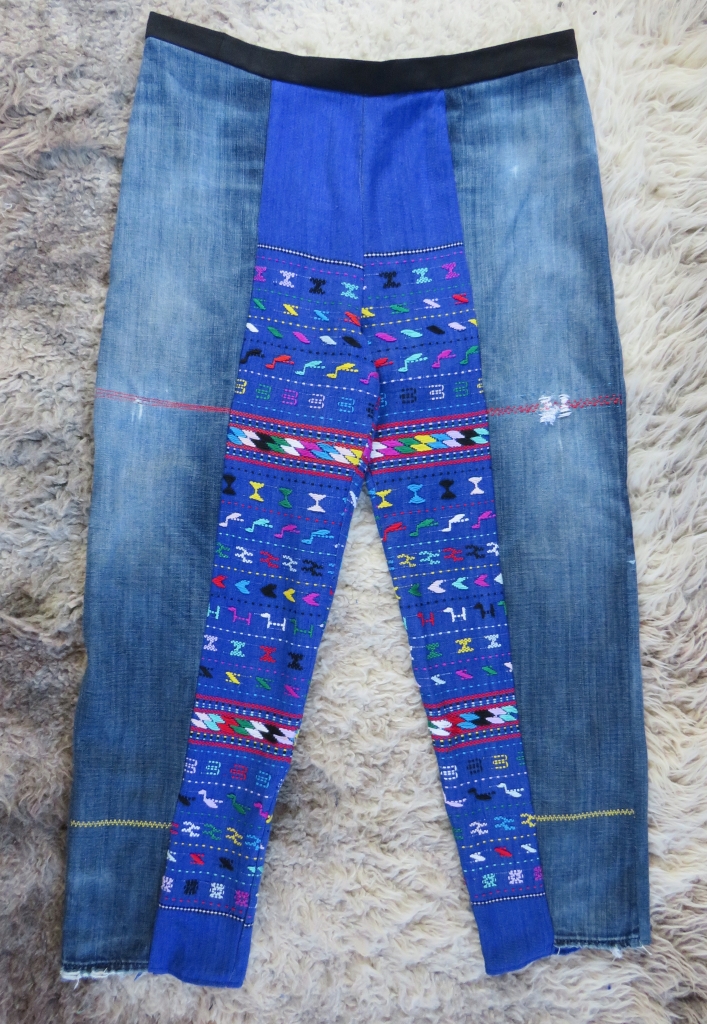
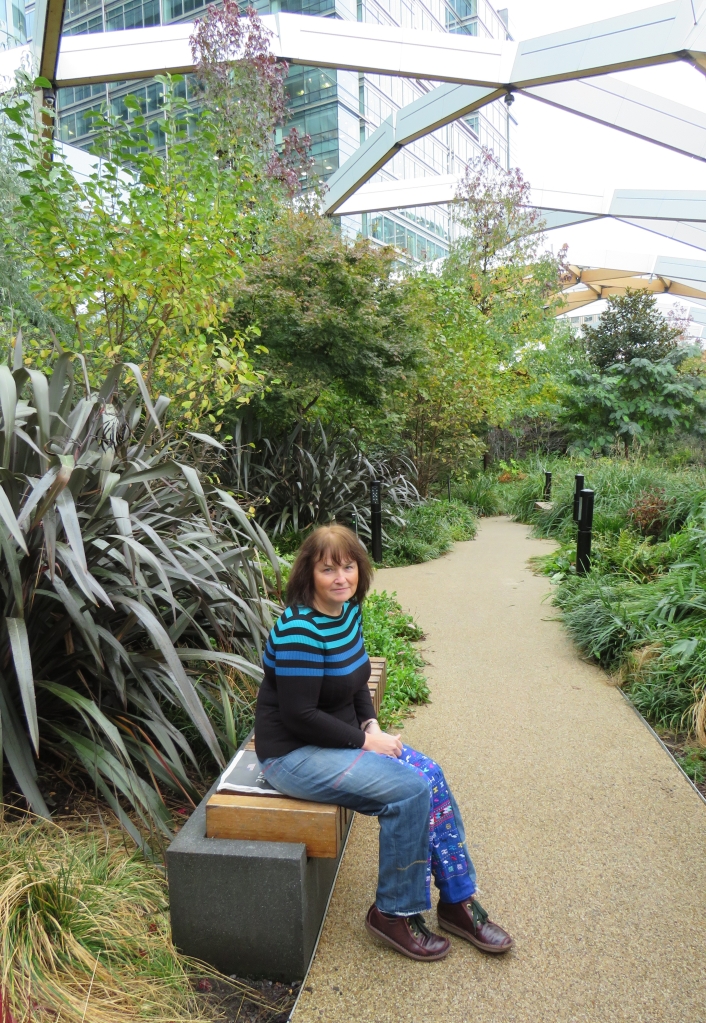
Another tablecloth make, technically a table runner which caught my eye at a jumble sale for next to nothing, paired with some old denim to make a pair of trousers. I had the table runner for about 2 years, auditioning and rejecting it for several projects before settling on the trousers. The table runner, having a loose weave, was unsuitable for trousers really but, despite being at the whacky end of my creations, I like these trousers so much they are still in my rotation, and in fact I have even been wearing them on the day of writing. They’ve had 40 recorded wears and I am currently deciding whether it should be 50 or not – some of the denim is getting thin and has already been repaired with an added pocket patch.
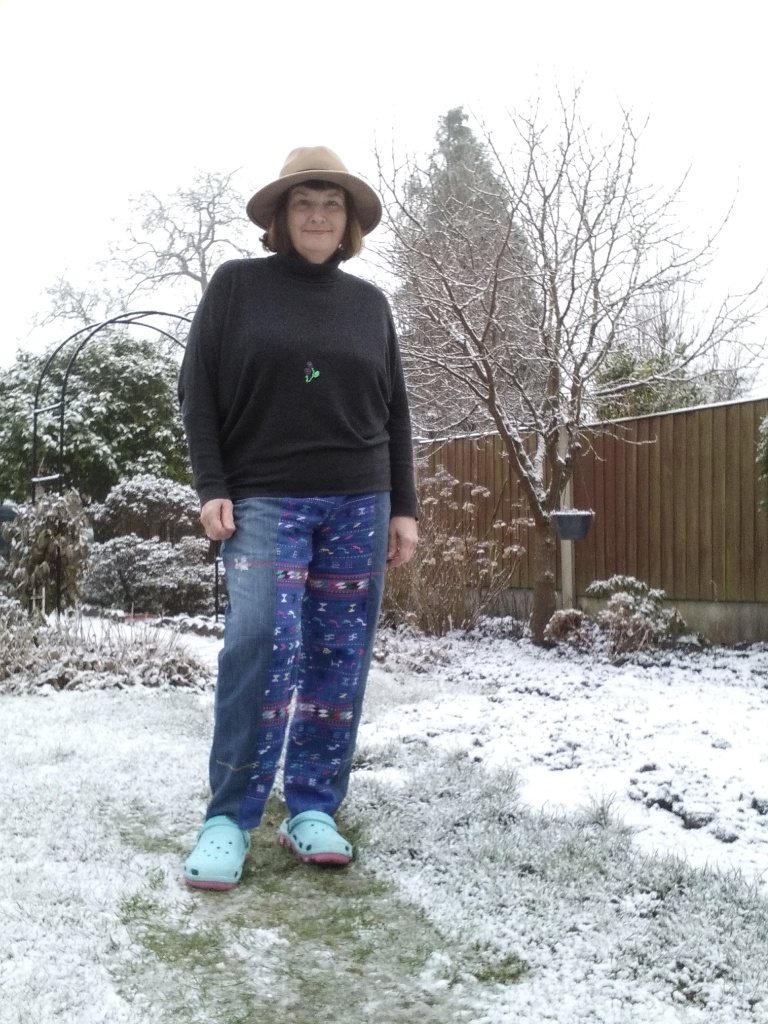
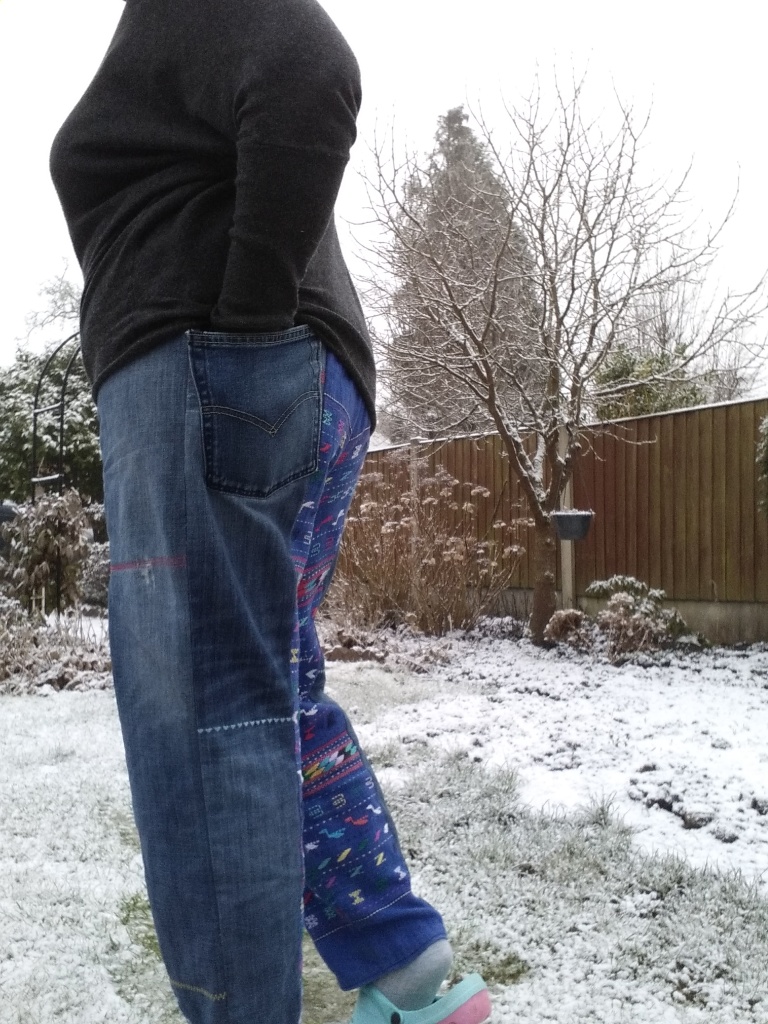
Simple Sew Anneka tunic
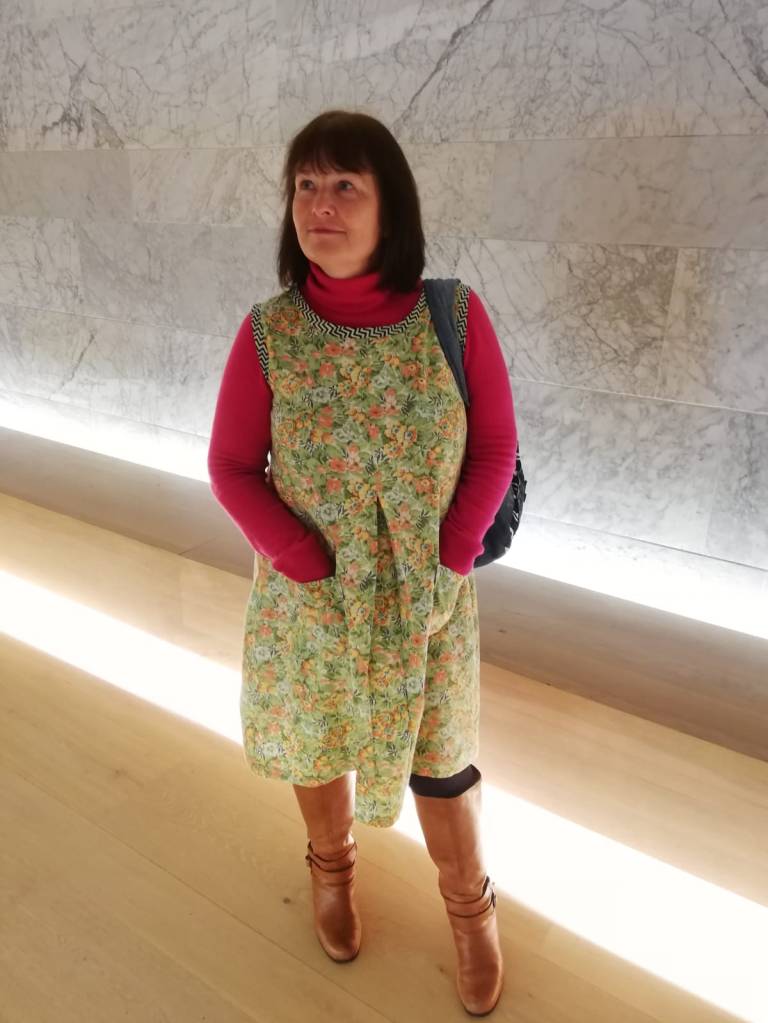
This was made from some actual fabric found in a charity shop – one of the first times this ever happened. The fabric is an old fashioned print and somewhat scratchy, synthetic and sweaty, however I do still own this dress. It’s had 30 recorded wears and will make 40 but maybe not more after that. I think it is a bit short and unflattering as well as the other problems to do with the fabric, but it’s still with me because it’s very loose and comfortable.
Purple flowers top
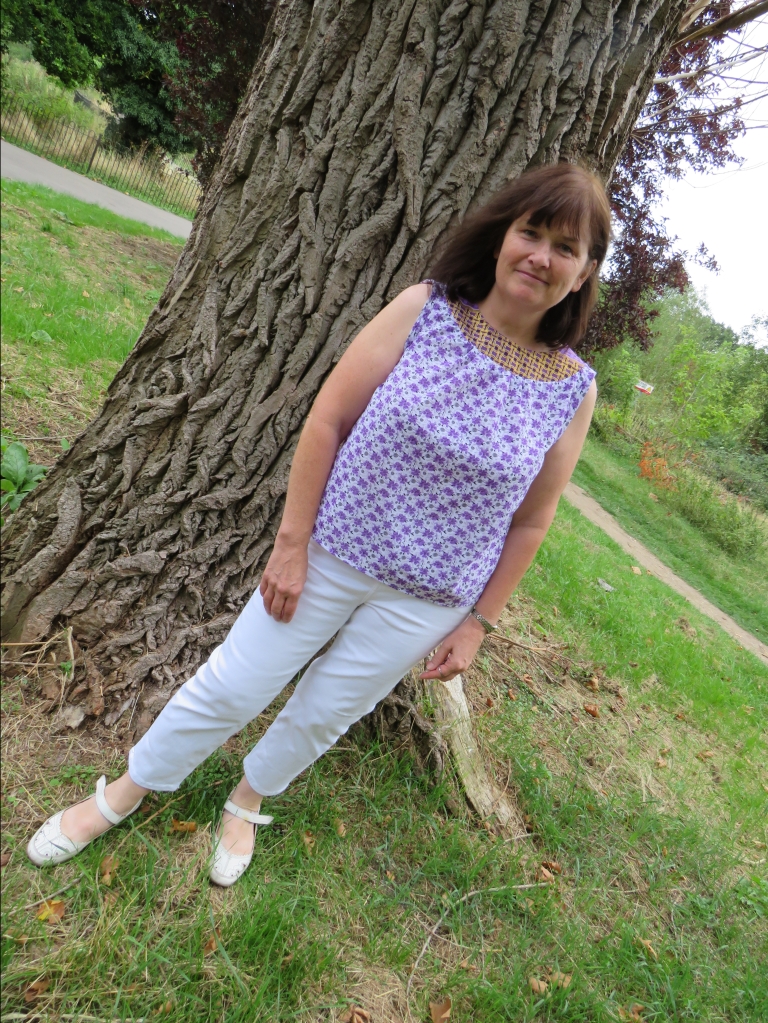
I made this from some purple wrap trousers which contained a lot of fabric I used the rest of the fabric to cover a piece of furniture. The top is still in my wardrobe but I’ve only worn it 10 times. It is a summer only wear and a bit tight on the bust. It will get to at least 20 wears although does count as a bit of a fail. I have 28 tops, which is too many for them each to get 10 wears per year and I do want to reduce this number.
In conclusion, 2018 wasn’t a bad year, I made a few more things than listed here but I don’t want the post to go on too long. I got a good amount of wear out of my makes and some of them are still with me now, but coming to the end of their life.
Sewing review 2021
It’s not been a bad year. Everything fit, not too many bad fabric choices, but I’ve still yet to complete a garment perfectly from beginning to end.
Two shirts
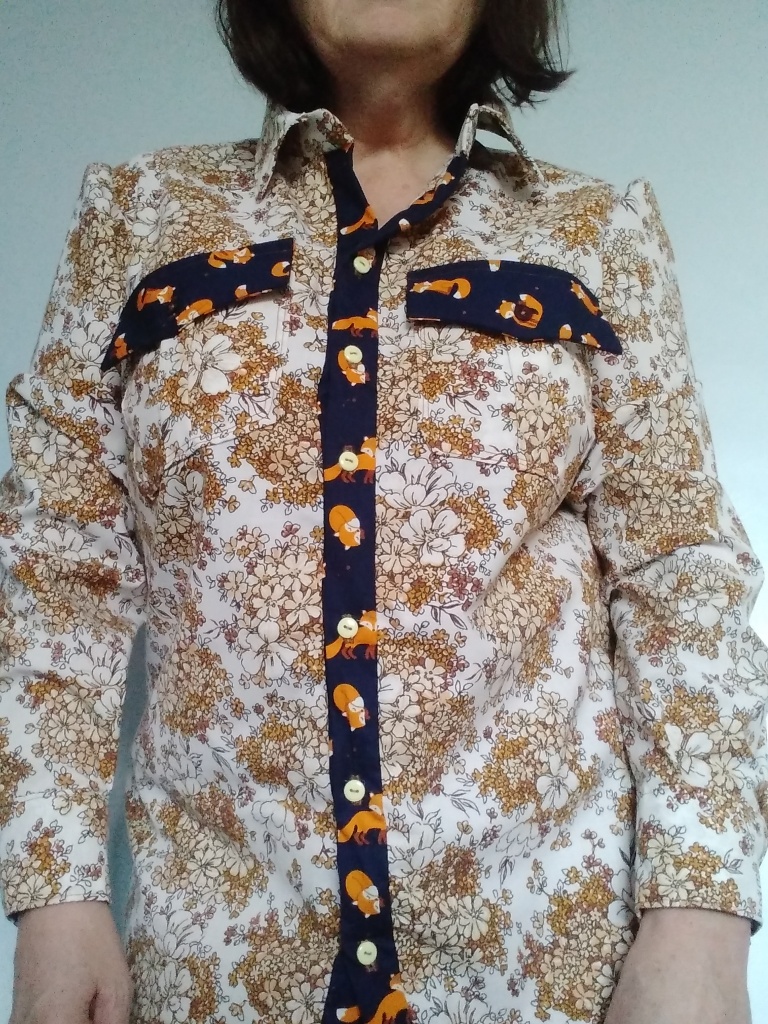
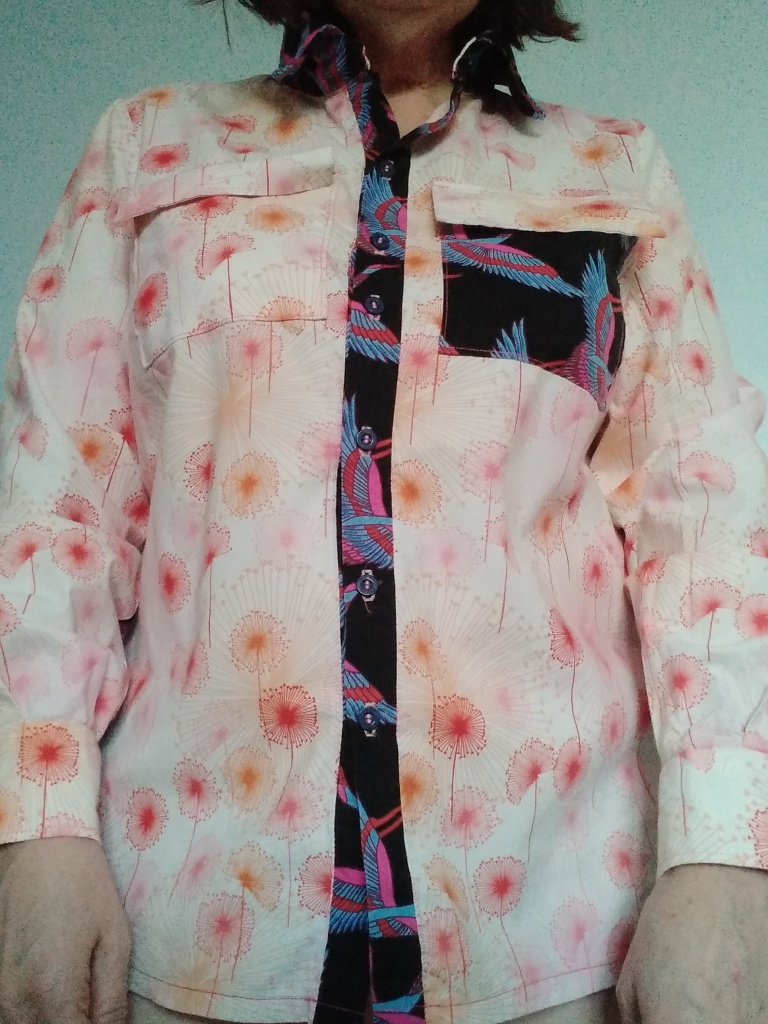
M6436 came along in Feb and March. I got the urge to sew a button down shirt and this pattern included different cup sizes so was a good starting place in terms of fit. The first shirt was that old favourite, a wearable toile, made from a vintage sheet and a small left over piece of cotton poplin. There were new techniques to learn which were button placket, collar stand and pocket flaps, but all came together without drama as the instructions were easy to follow and the fabric was well behaved.
I shortened the length of the second shirt and made different pockets. Fabric was quilting type cotton.
Although pleased with the sewing and fit of these 2 shirts they are difficult to wear, in fact I haven’t started wearing the toile yet. The cotton one has been worn 6 times. I have a lot of tops and it’s difficult to fit new ones in, the shirts were too warm for the summer months, the patterns are loud and they are too long to wear with skirts. I wouldn’t rule out making this pattern again but would have to be a short sleeved, shorter, quieter version.
Interfacing – obviously this pattern required it in the collar, cuffs and pocket flaps but I used an extra layer of cotton in place of interfacing. I have yet to find any which doesn’t transform into a web of useless mush after about 3 washes so have given up using it.
Four pairs of trousers
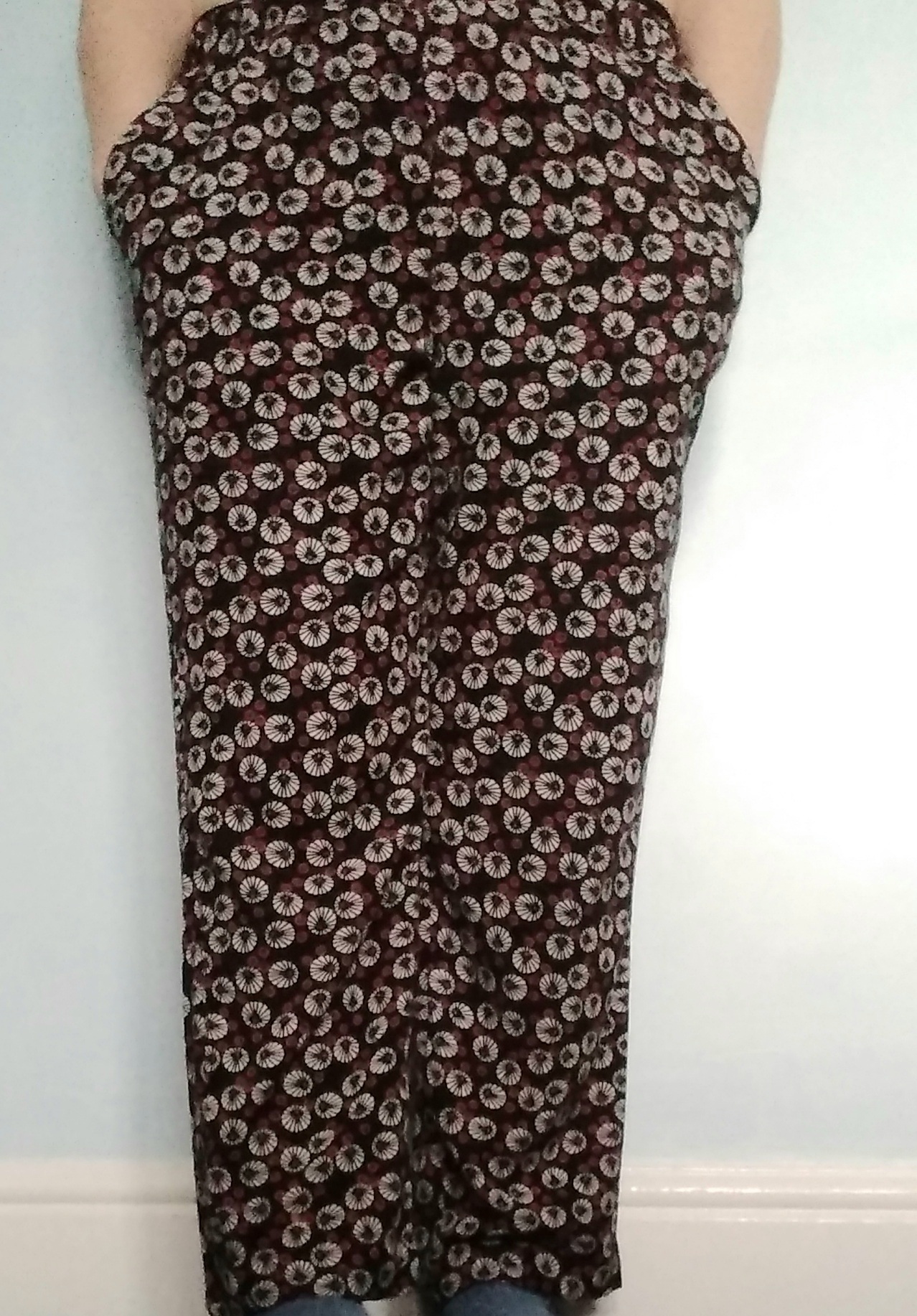
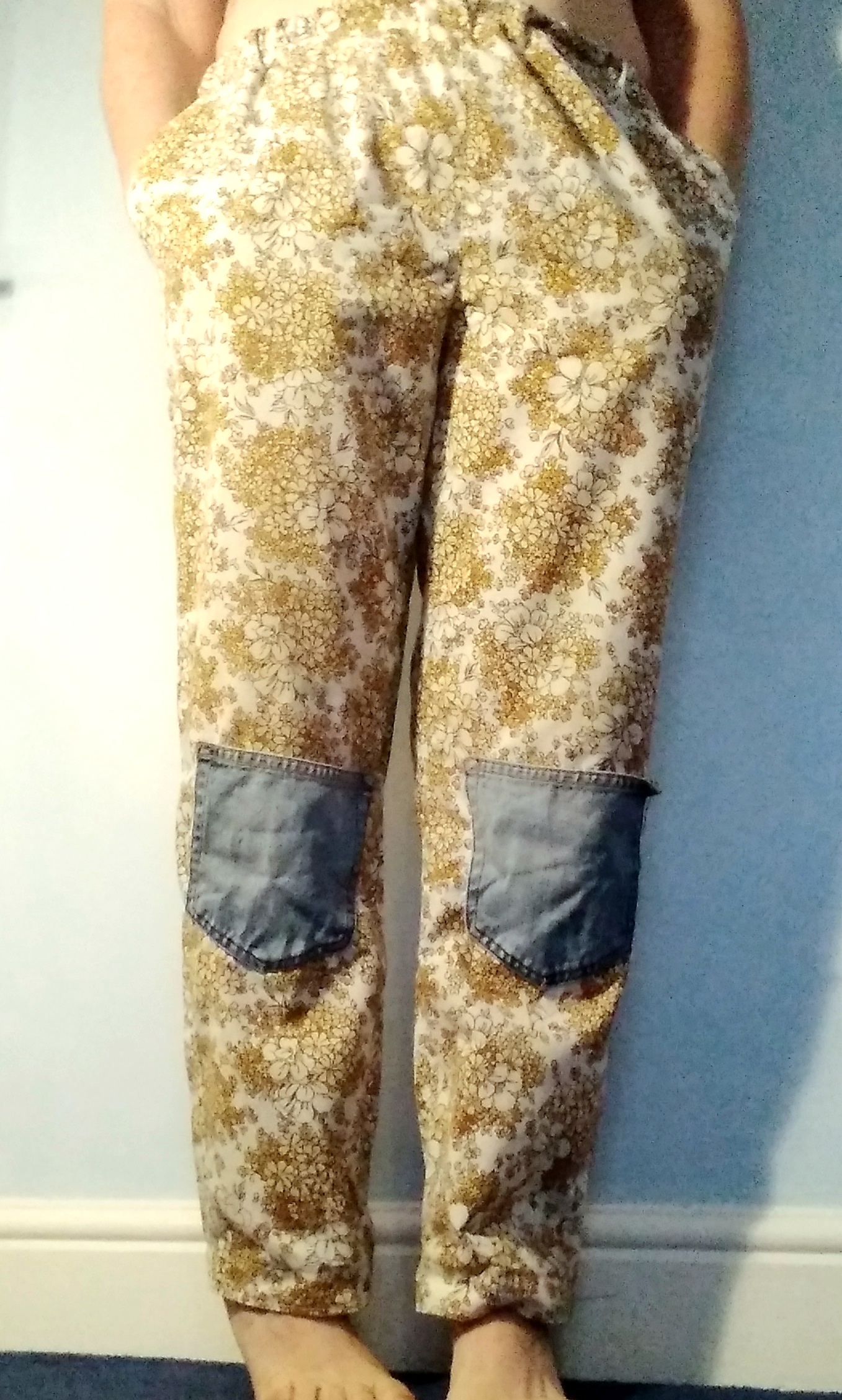
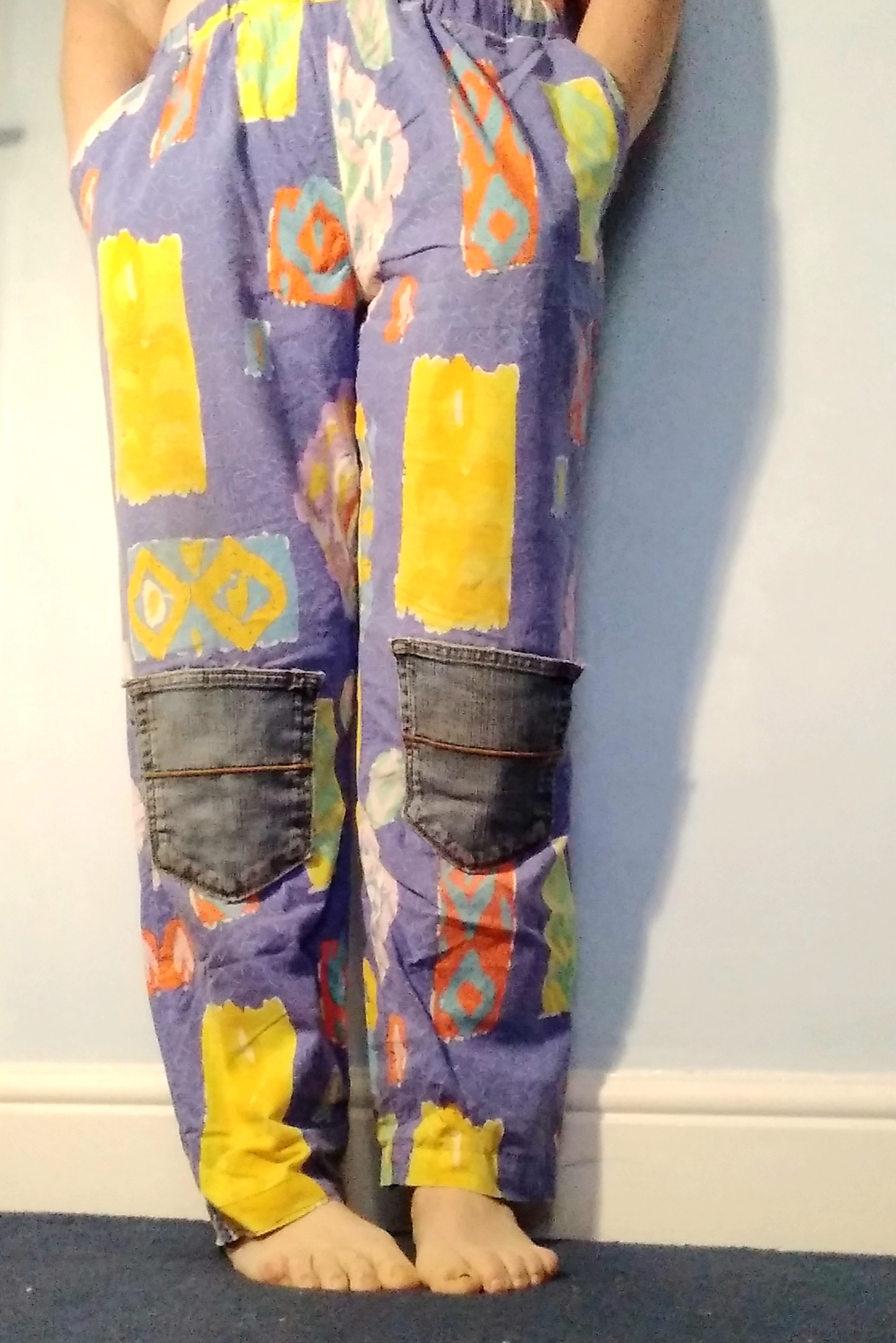
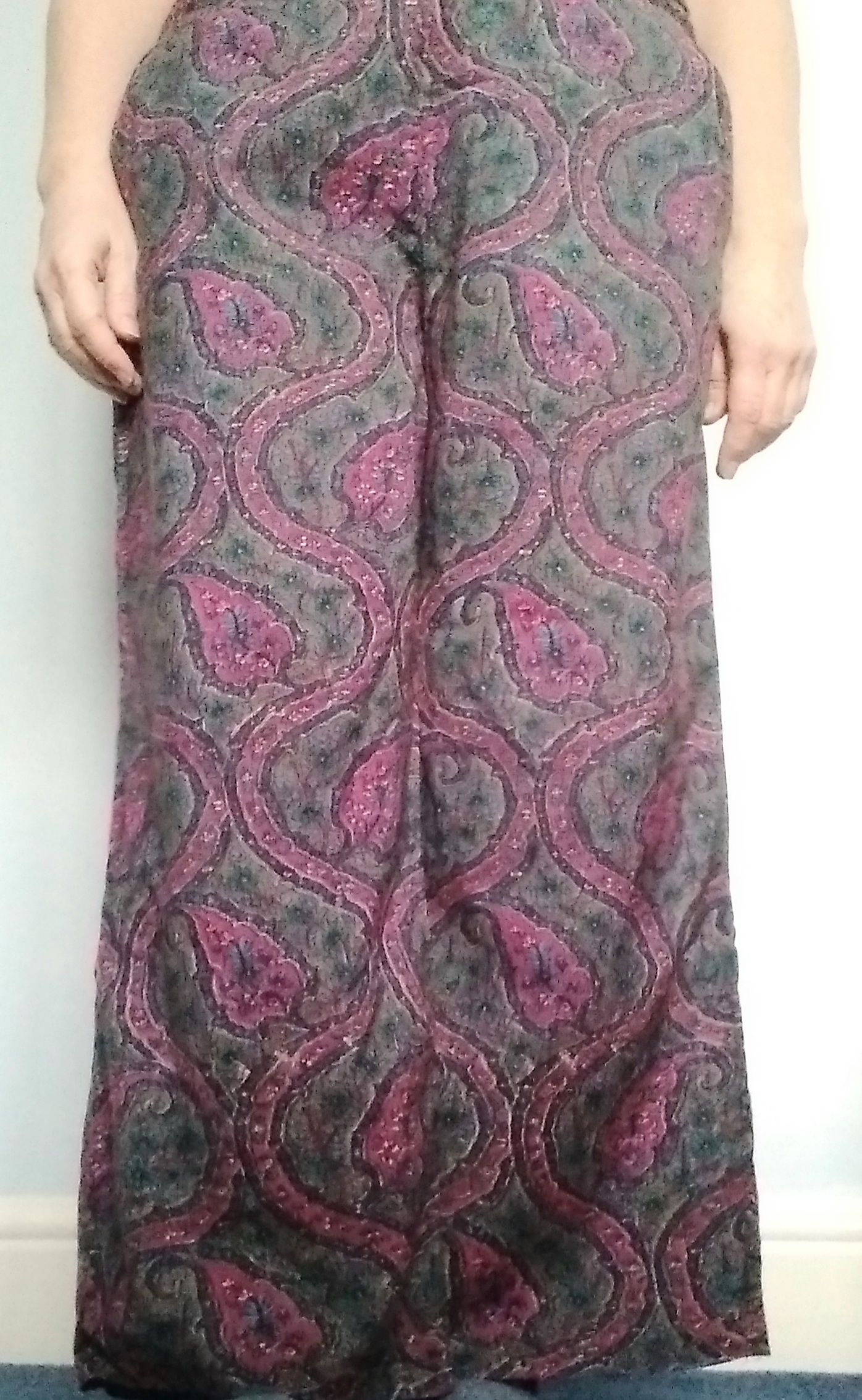
I sewed 3 x Helen’s closet Arden pants, my 5th, 6th and 7th ones in Feb and July. Number 5 was made from new viscose fabric left over from making some of these pants for my daughter. Of course there wasn’t quite enough and I added some toning pocket detail. These trousers were almost a perfect sew, I’ve had enough practice with this pattern after all, except when I started to wear them I realised that one of the leg pieces had been cut off grain which makes that leg hang twisted. At first I found this very annoying but now I barely notice it. I’d cut so many shapes out of the fabric at this stage so much there weren’t many clues which way the grain lay and the fabric design wasn’t directional at all. This would explain why I initially thought I would have to join one of the leg pieces then managed to cut it in one piece. So far they’ve been worn 17 times.
Numbers 6 and 7 were made as gardening wear – I do paid gardening work which is very hard on trousers and soon saw off 3 old pairs I had been using. One of the Ardens was made from the same vintage sheet as I used for the shirt toile, and the other was from an old duvet cover. I added jeans pocket knee protection to both. They are both a big success and have been worn and washed weekly since July.
In May it was time to try a different pants pattern and used K8175 which also has a skirt version which I have made a couple of times. The fabric is a fairly thin polyester crepe from a de-stash and these trousers turned out OK but I initially made the waistband too big and had to go back and alter, and the zip installation isn’t great either. They’ve been worn 10 times.
Two Yanta overalls
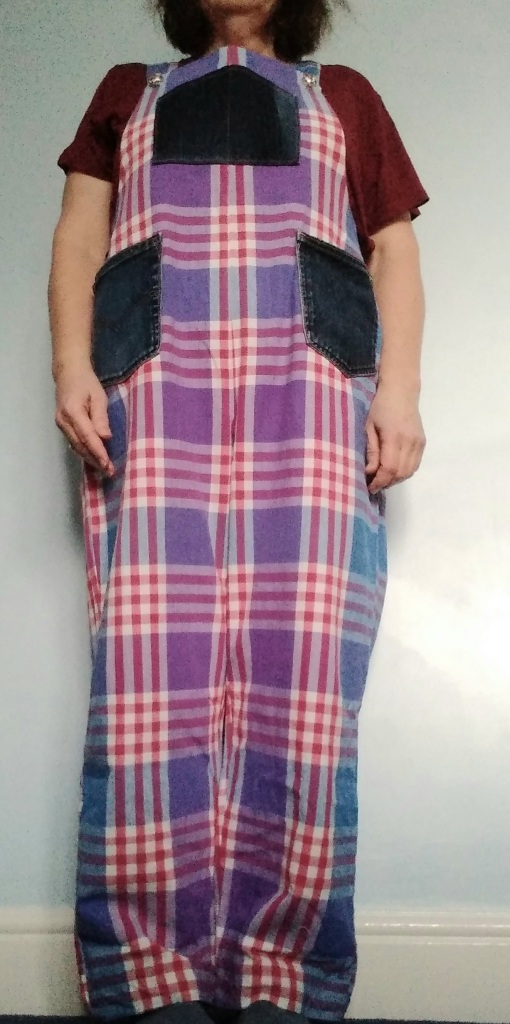
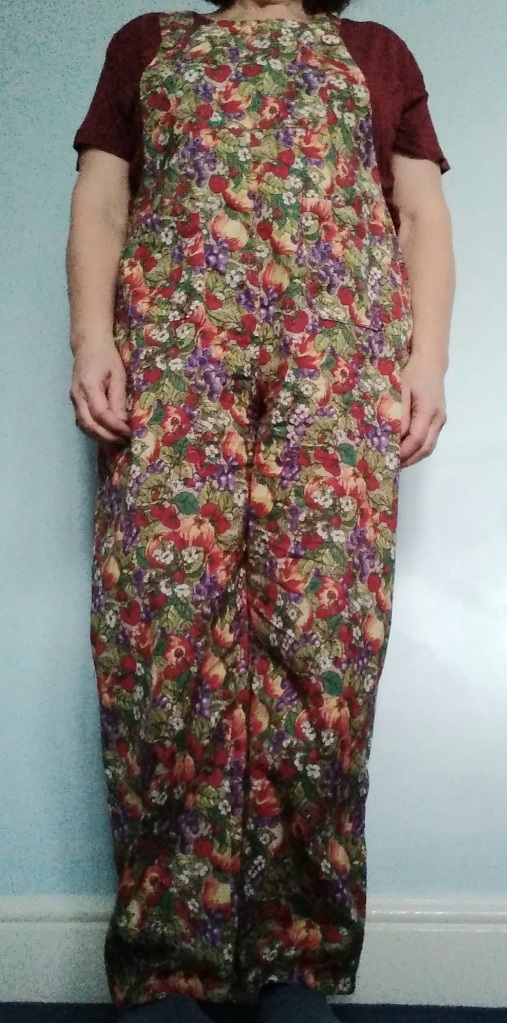
I am a big user of Helen’s closet patterns and this one looked so comfortable I had to try. The fabric for the first version was an Ikea tablecloth bought at a jumble sale for pennies. With so much ease and no bust fitting required, I made a straight size 16, but went back in to make the hips and legs smaller. Currently the most comfortable clothing I own and have been worn 10 times. The second pair, which quickly followed the first, was in what I believe is 1980’s liberty lawn found in a charity shop de-stash. This time I sewed a straight size 14 and shortened the body by a couple of inches, which I now regret as the extra room is useful when sitting down. I had been wondering what to do with this precious fabric for some time and liked the idea of sewing dungarees in a posh fabric, and I’ve used them as evening wear. Also a success, the fabric is quite thin and they’re not that warm. They’ve been worn 4 times.
Three jumpers / sweaters
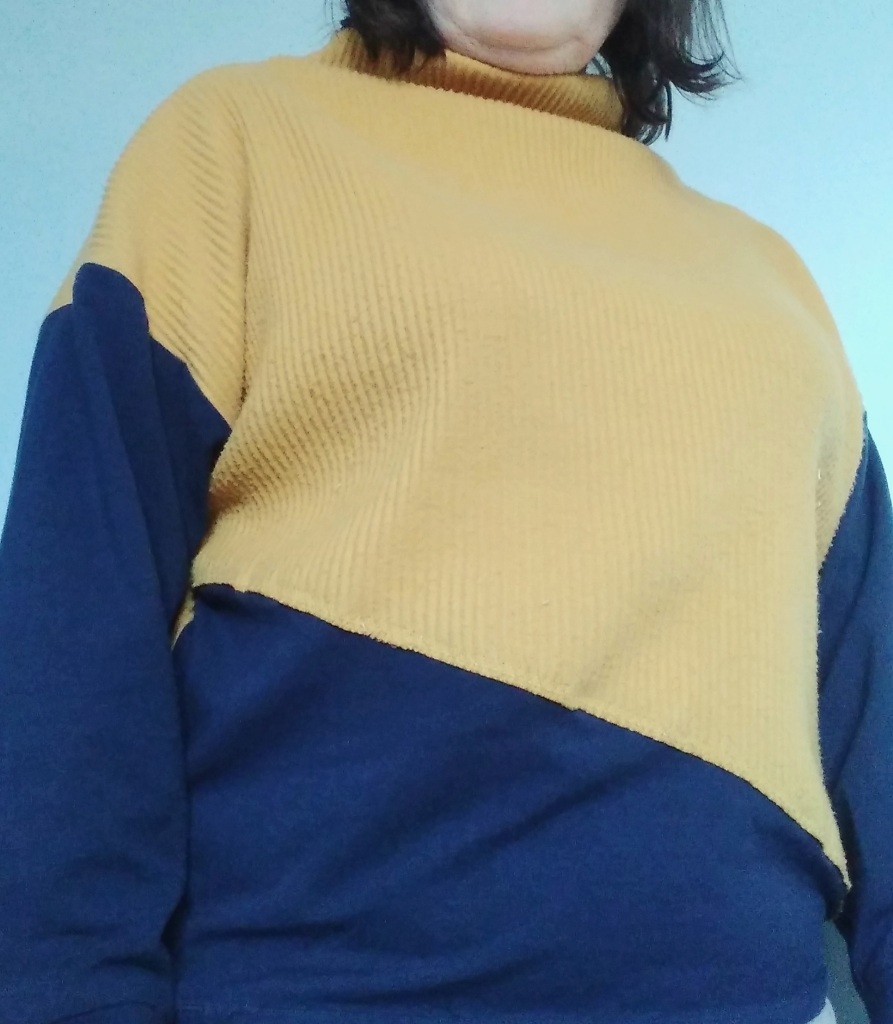
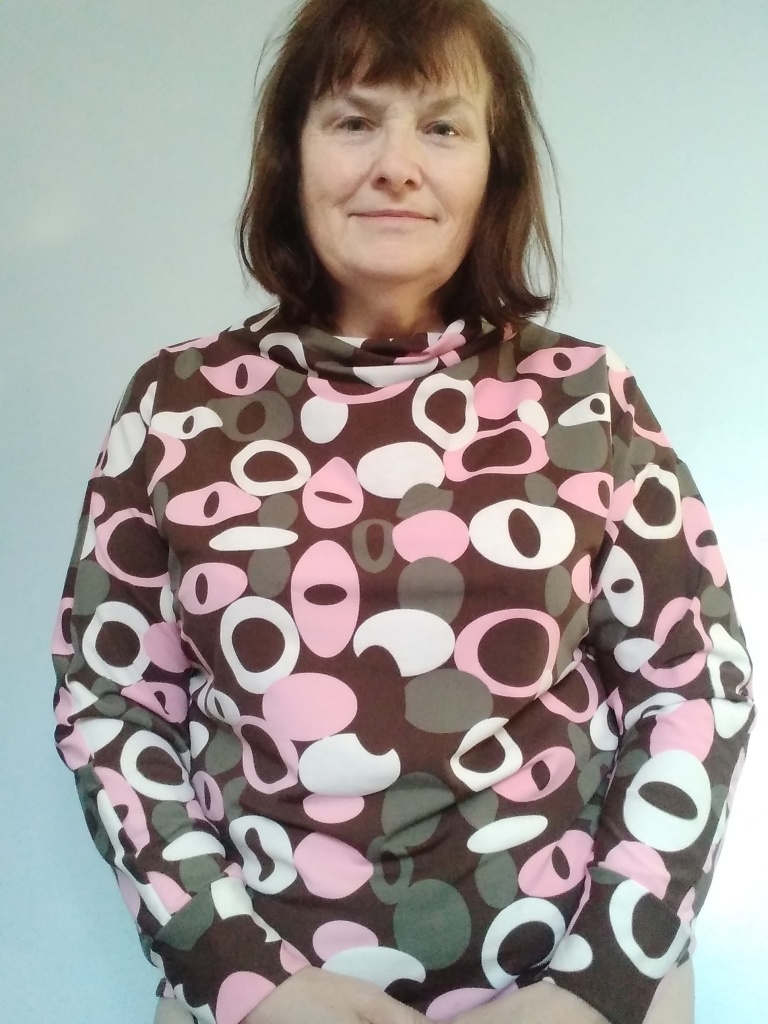
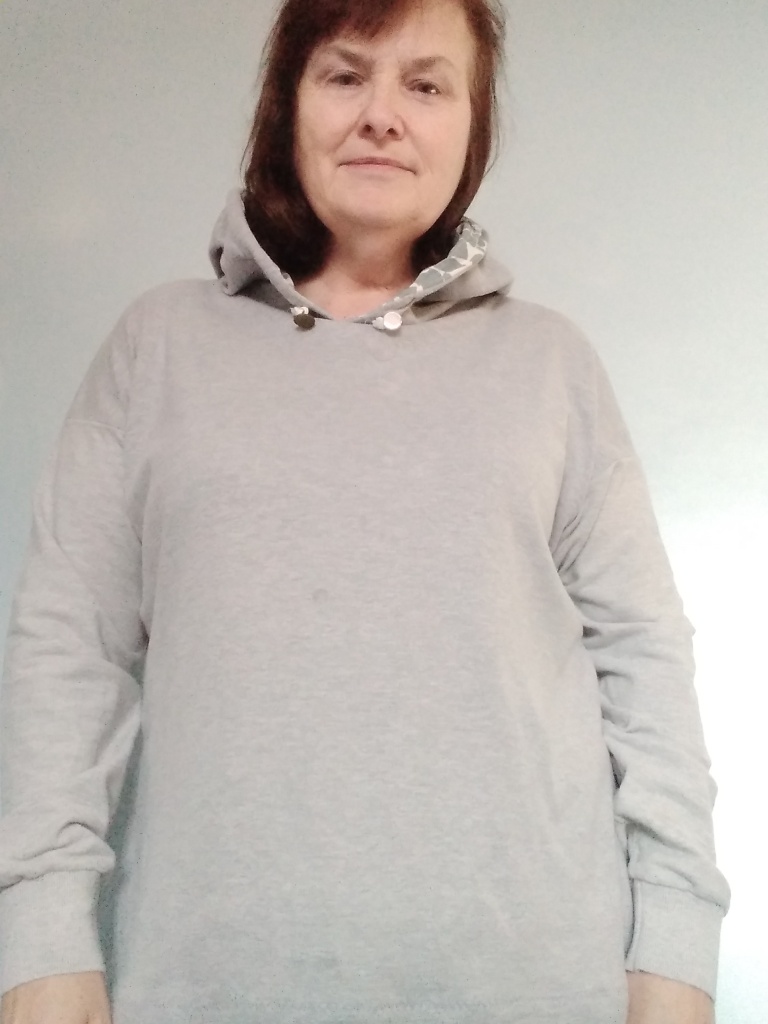
In November I made 2 versions of K8529 which is basically the Sew House Seven Toaster sweater. The first one was a straight size L (but shortened and no high low hem) made from a scarf which was given to me as fabric, supplemented with some navy jersey. The scarf fabric was ribbed and the ribs ran diagonally so it was always going to be tricky to marry the two together. What I learned from this make was that the pattern was a good one, its USP being the neckline which is a cross between a boat neck and a turtle neck. The pattern piece is an odd shape folded back on itself to make a facing, which is then sewn to the shoulder. I really liked the way it is close enough to keep your neck warm without feeling tight. I immediately followed up with a 2nd version in ponte as a straight size M. This was a perfect fit and also one of my favourite makes of the year. The scarf one has been worn 6 times and the ponte one has been worn twice.
In October I made a TATB Stella Hoodie. For the body and hood I used some cotton jersey and for the sleeves and cuffs I used an old polo shirt in a similar colour. My twin needle was not particularly keen on the jersey and kept skipping stitches. It was an easy sew which came together well, and is a rare and useful neutral in my wardrobe. I made a size 7 but next time would make a 6. It’s been worn 10 times.
Two skirts

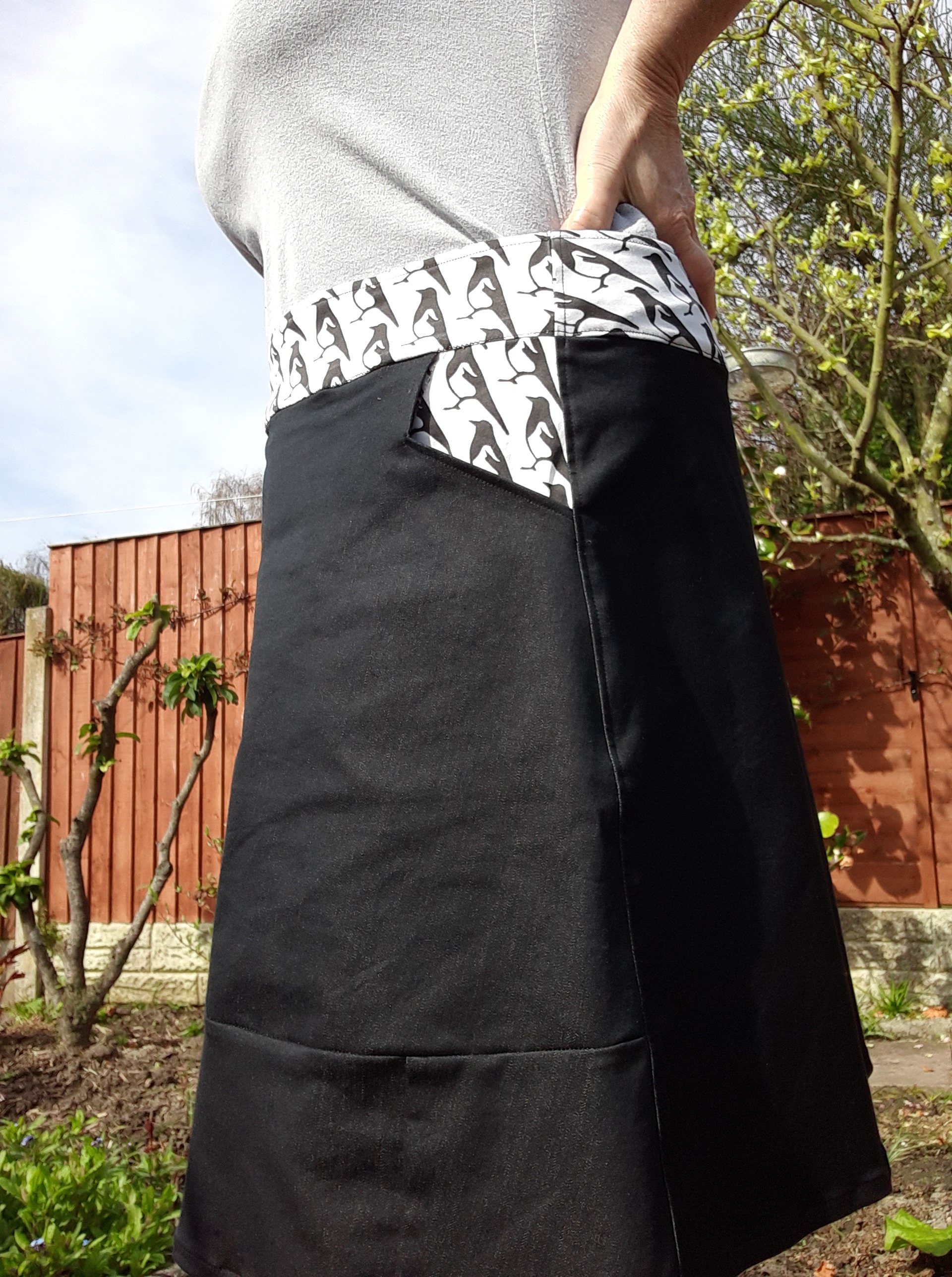
In Feb I made a second MiY patterns Kelham skirt in vintage Welsh wool which my mother had bought many years ago. I made the terrible mistake of pre-washing the fabric which both shrunk it and felted it. I steamed and pulled at the wet fabric but the damage had already been done. This is an error I am never going to forget. Determined to still sew the skirt, I just about got the main pieces out of it by shortening the length and using smaller seam allowances. It’s been worn 10 times.
In April I made the ‘seeing red denim skirt’ with a free pattern downloaded from Love Sewing magazine. The fabric was black denim with some stretch, and as usual there wasn’t enough of it, some piecing was involved. It’s also been worn 10 times. Both of these skirts are OK but not favourites.
One dress
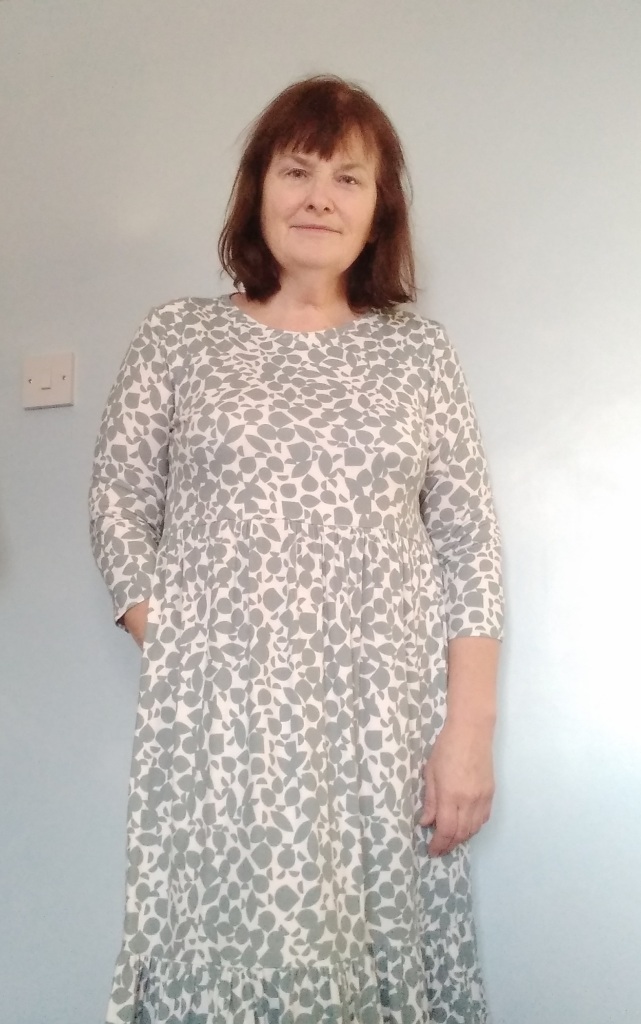
In March I made M8085 in a bamboo jersey purchased from a local independent fabric shop. The fabric was similar to the one on the pattern envelope. This has been a good versatile dress suitable for many occasions. It’s a little warm for high summer but with a vest and boots has been quite serviceable for winter. The plain front design makes a good backdrop for necklaces. The dress is physically quite heavy, and there’s a full length version which would be pretty weighty. It’s had 11 wears.
A re-fashion
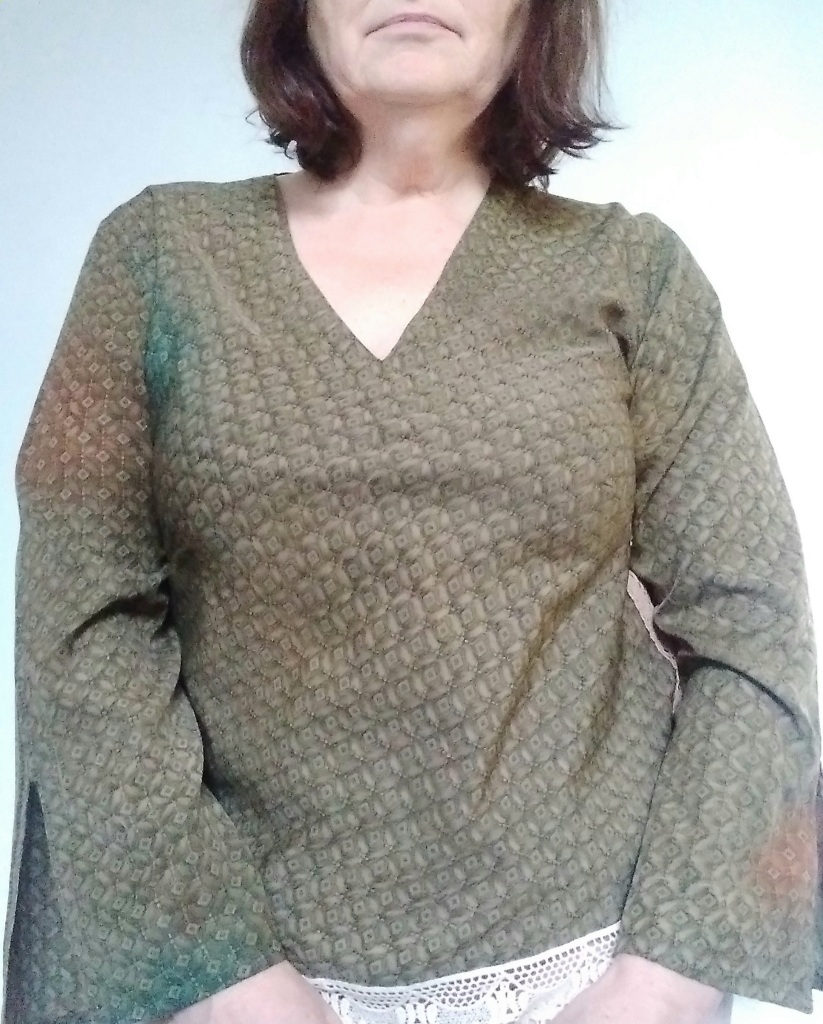
A friend gave me a pure silk top which she no longer wore. It was too tight on the bust so I added a lace side panel and moved the darts. It’s not been worn yet but soon will be.
Sewing plans for 2022
I’ve got a lot of patterns and fabric but don’t like to sew up a lot of things which won’t get worn. I do love sewing though, it’s a constant dilemma. Only definite plan is for a shirt dress, M8030, and vague plans for more Yanta overalls and maybe a cardigan, but inspiration will surely come as the year goes by and the urge to stitch gets stronger!
2 more Suki Robes
I have plenty of clothes, so how can I justify making more?
Here, my friends came to the rescue (actually they probably have more clothes than me but it’s their guilt now not mine).
On our weekly zoom chat I was moaning about having lots of fabric and wanting to sew but not needing anything. My friends said ‘you could make something for us’
I am generally not keen on making things for other people. Too many of us have got used to the idea that clothes are not valued, and are disposable. I have seen this in practice when sorting through charity shop donations. I choose my gift makes carefully.
In this instance the gifts were to be Helen’s closet Suki robe’s. This pattern works best in light weight fabrics to be used as a summer dressing gown. It’s good to make as a gift because there are not too many fitting issues – loose fit, wrap front.
I gave my friends some 100% cotton fabric options to choose from then ordered accordingly.
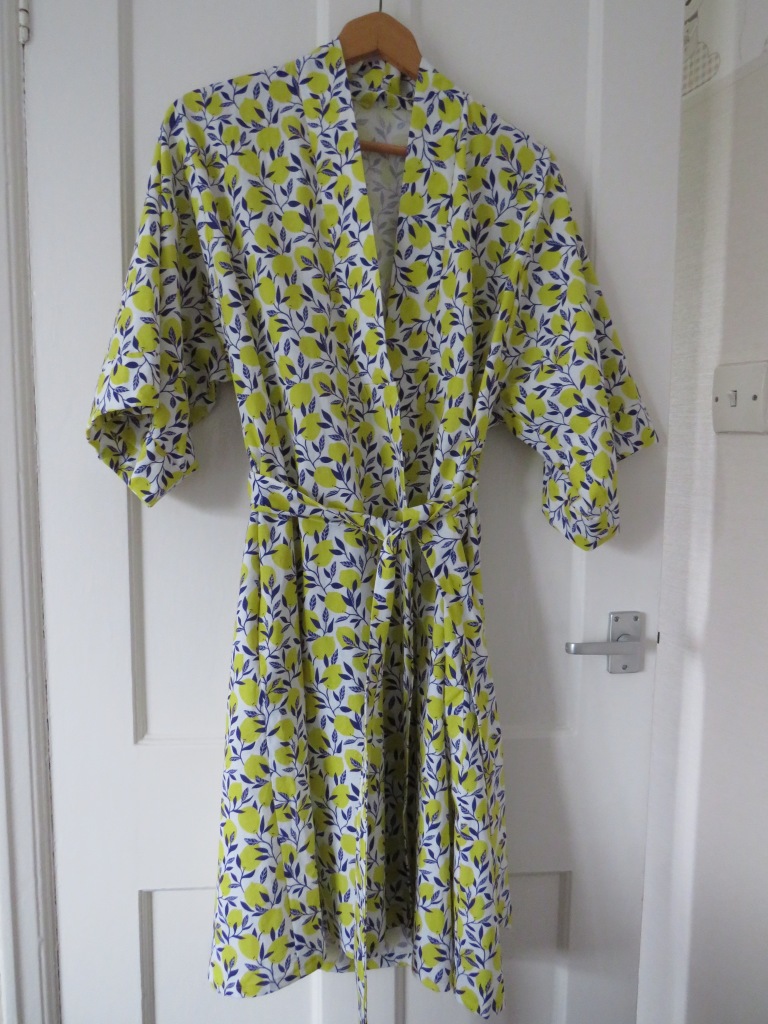
I made this one from fabric bought on ebay for £9 per metre, 2.5 metres purchased. My friend identifies with Sicily so I chose the lemon fabric. There is huge error which is the lemons hang upwards but I was focussing on the leaves which I thought lookd better pointing upwards.
I made this one from Japanese fabric purchased online for £18 per metre, 3 metres purchased.
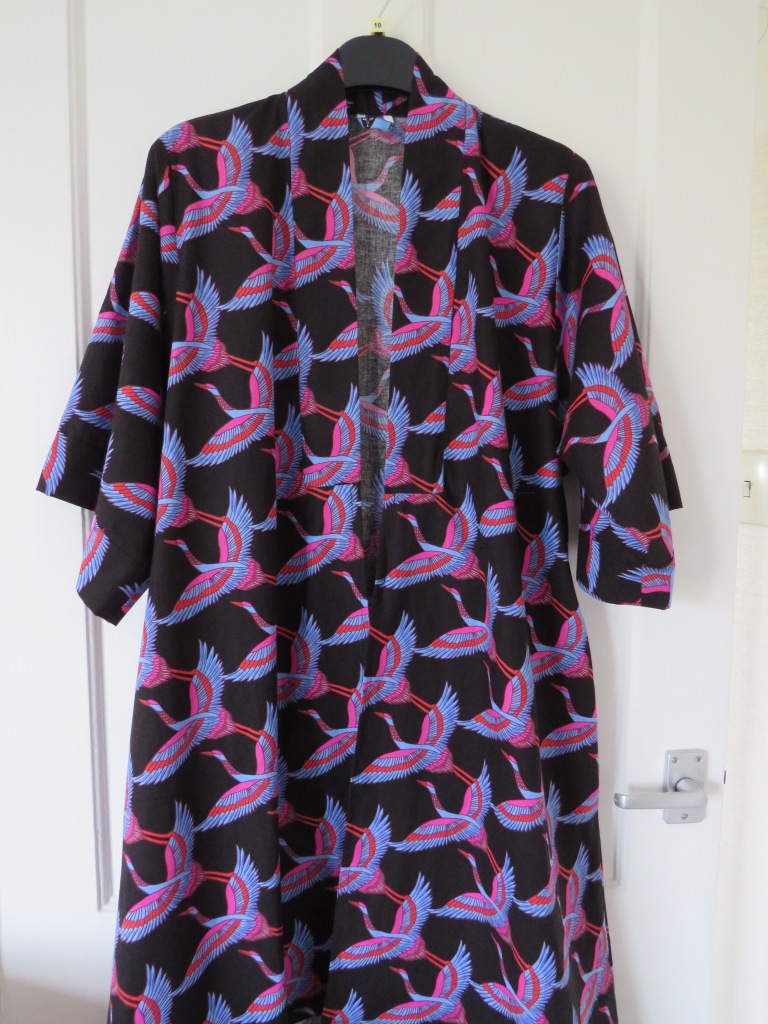
This is probably the best quality fabric I have ever sewed. It just oozed quality. The birds and colours are amazing, I think they are storks. Despite this being a size small, there was not much fabric left over from the 3m I bought. I imagined myself pattern matching but that was beyond my skill level and I had to content myself with all the birds flying in the same direction.
I tried both on, and the lemons one, being my size, was a lovely fit, but disconcertingly the stork print looked all wrong because it would not close properly and even the neck was too small. I will just have to hope that Helen knows what she is doing and this will look wonderful on my small sized friend.
Having sewed 2 Suki robes in 4 days I am now familiar with the pattern and have some observations.
- French seam the shoulder seams
- Don’t bother with the belt loops
- The front overlap is quite small, don’t skimp on sizing in this area.
- Its a great pattern
I love sewing, its rewarding and challenging.
Silk blouse refashioned bigger
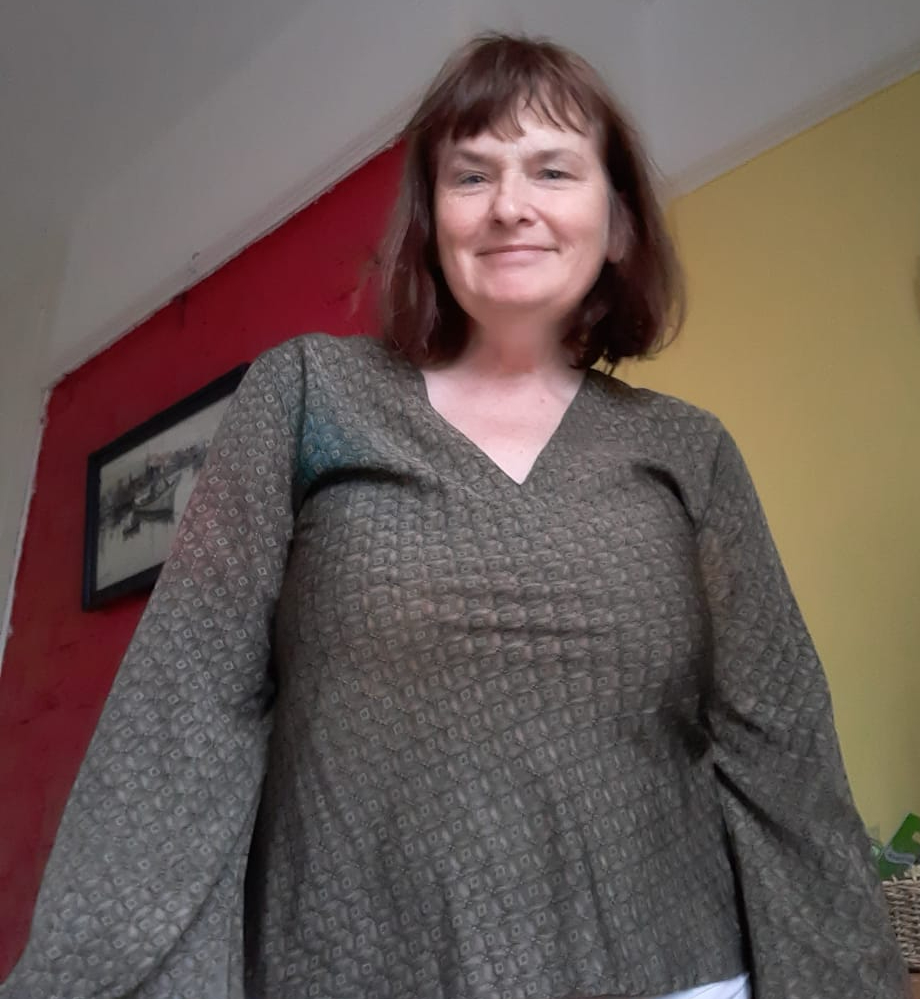
My friend gave me this 100% silk blouse which was cut on the bias but there was zero ease around the bust area.
The sizing in this blouse was XL but the dart was really small and I can not imagine are many XL women for whom the dart would be correctly positioned.
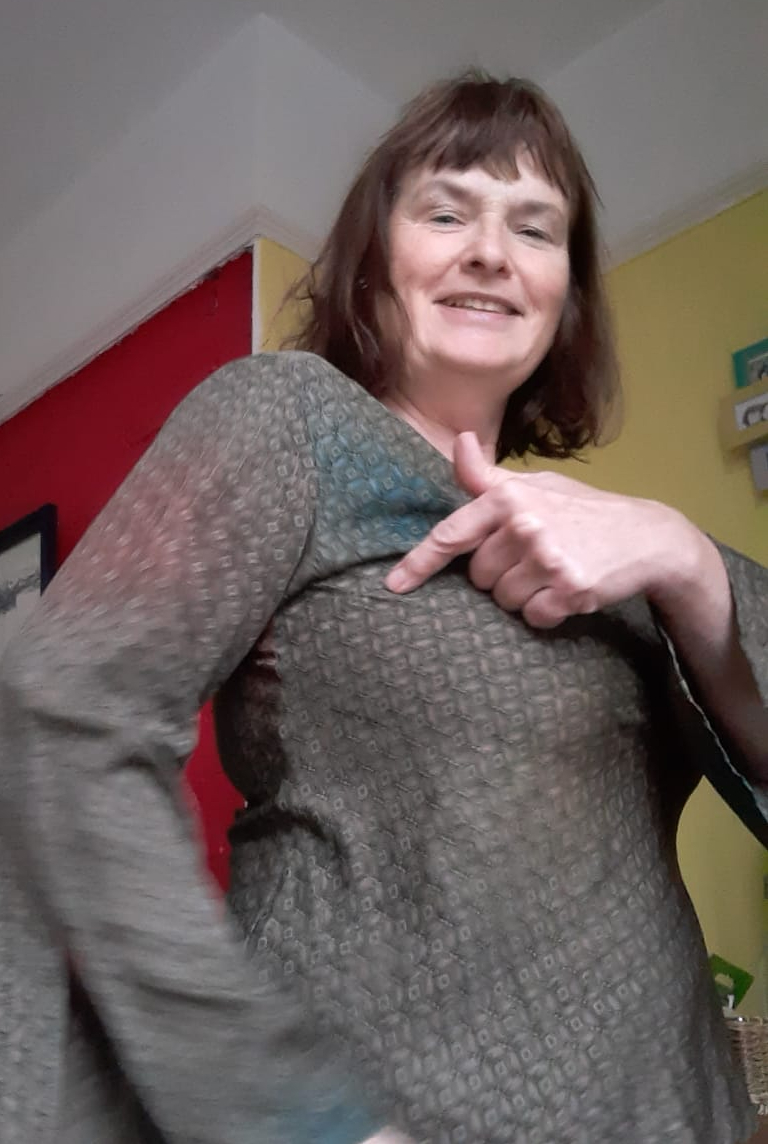
I decided the fix would be to add a little more ease down the side seams, increase the size and position the bust dart.
Un picking the side seams and original dart was straight forward enough but revealed there was very little side seam allowance.
I made a new dart by pinning using a mirror. The bias cut fabric meant that the two sides often looked asymmetric when I was trying on, so I just had to trust to measuring to get it right.
I selected some lace trim to add into the side seam. The lace only added around 2 inches of ease in total because I had to use some of the original seam allowance to join it, at least with the bias cut there was no fraying.
I also added some different lace at the front bottom edge to make up for the fabric taken up by the larger dart. I suppose the side lace is meant to be functional and the bottom lace is meant to be decorative.
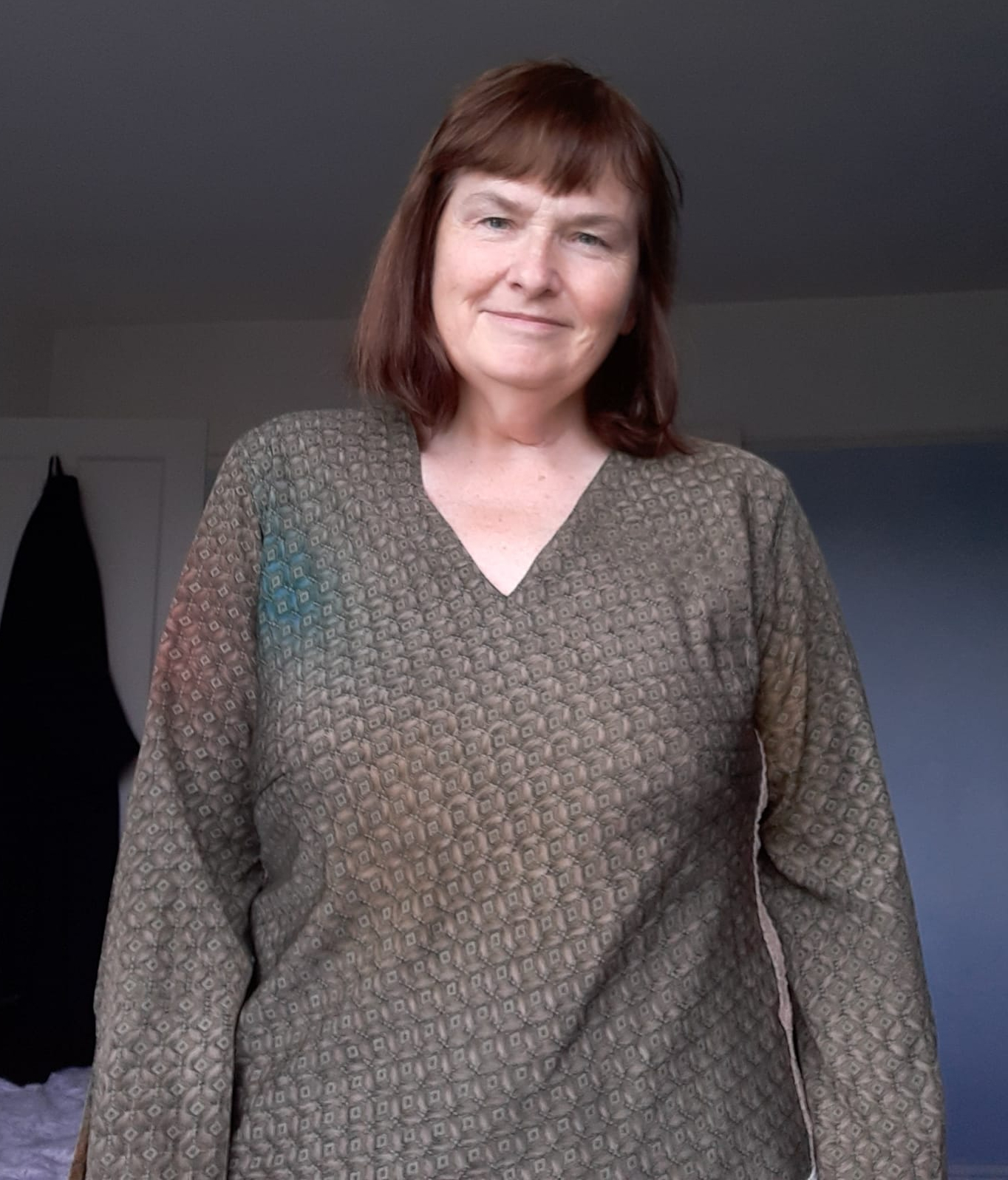
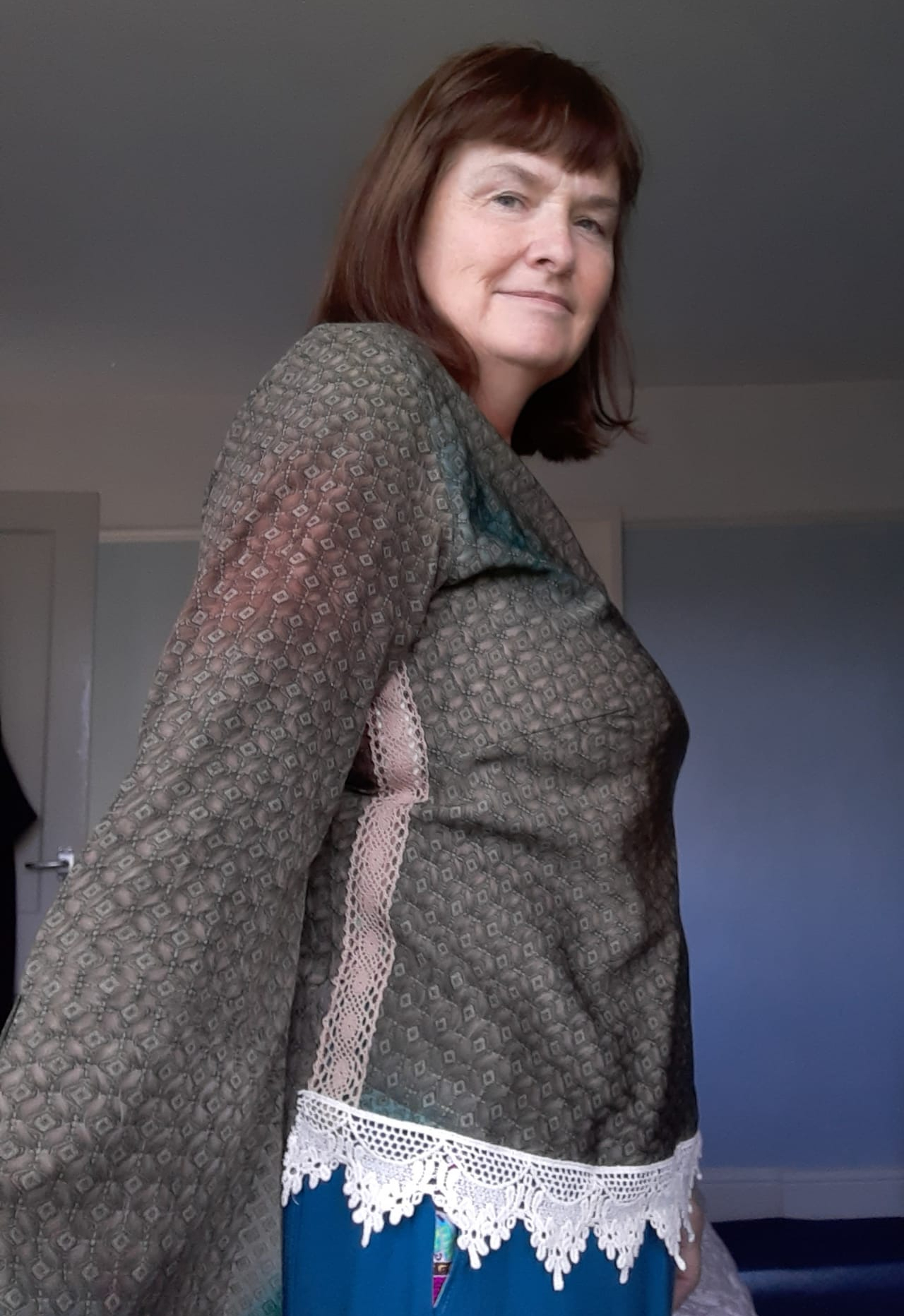
It’s been a while since I’ve done a refashion like this so felt the pressure was on to produce something with a good finish as I’ve done a lot of sewing and gained experience since.
Sew wear are they now? 2017 edition
I made / refashioned 11 items of clothing in 2017, 3 of which I still have. Here I am reviewing a representative selection.
I used to spend more time on pinterest than I do now, and spotted a cute t-shirt transformation which looked easy to copy.
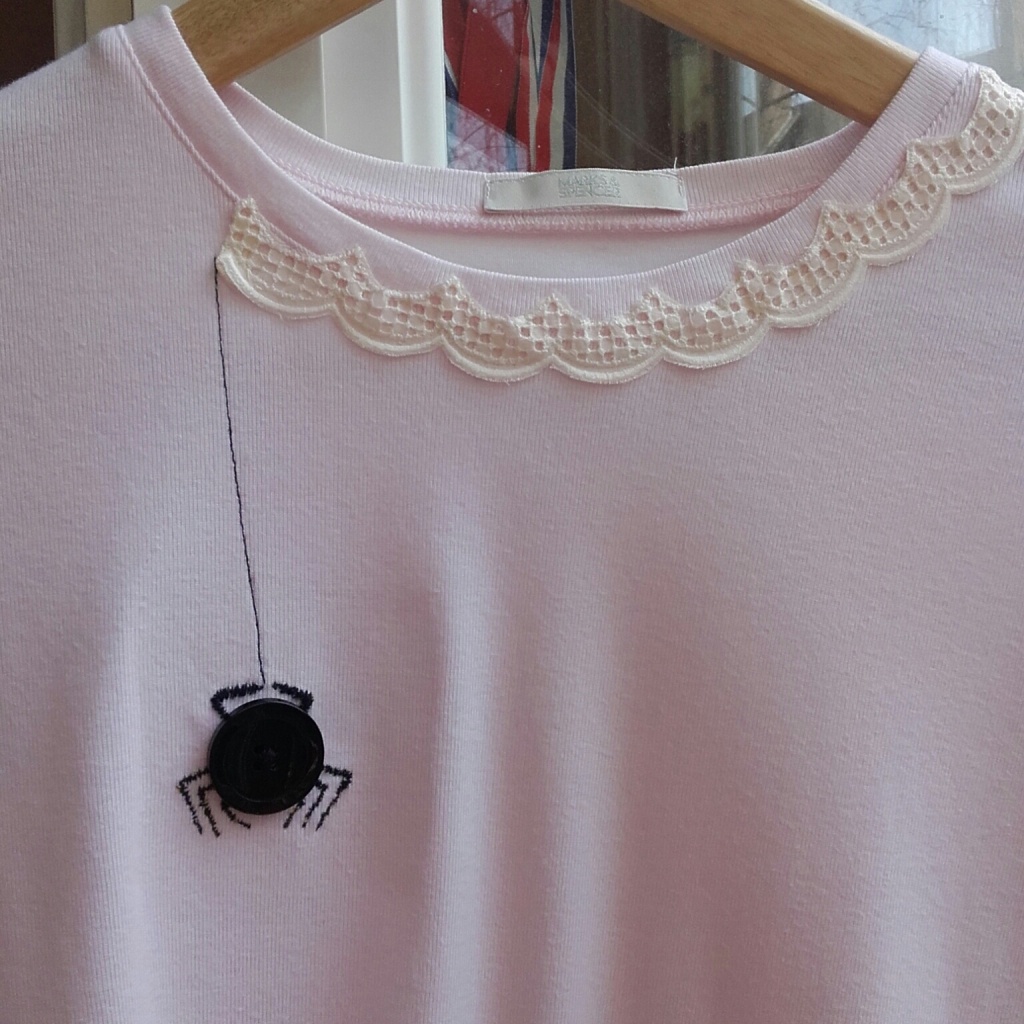
This t-shirt got comments whenever I wore it, even children who could barely speak would notice it.
For some reason I later decided to shorten the hem and add a band of lace to the hem, but this ruined it – just made it look wrong.
The base t-shirt which I got from a charity shop was more worn than I realised which also limited its life.
positives – always got me noticed
negatives – took it a refashion too far
estimated number of wears – 20
I discarded this re-fashion in March 2020
I made a top from a good quality large size men’s shirt.
It was a simple re-make where the back becomes the front, I cut off the sleeves, added some bust shaping and bias binding.
I remember being quite pleased with the bias binding but the darts look a bit dodgy.
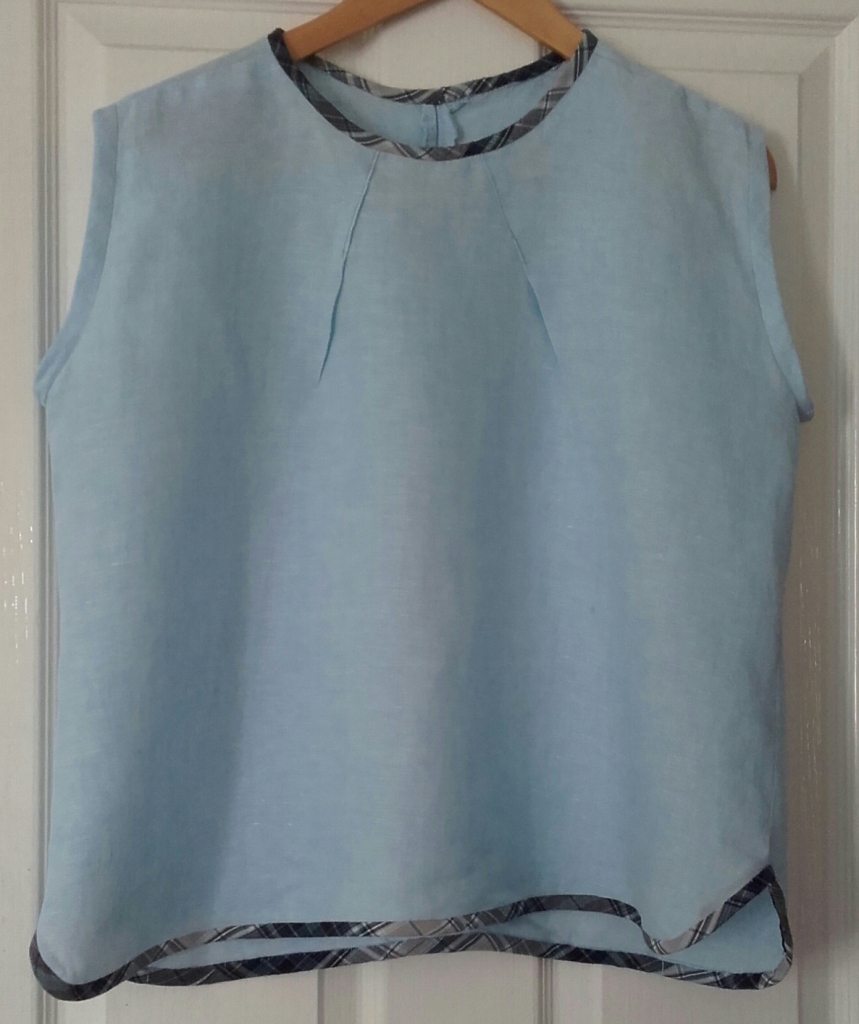
This top has had a good amount of wear but has a limited wearing season of high summer.
Positives – nice colour, simple garment which goes with anything
negatives – creases within 5 minutes of putting on
Estimated number of wears – 31
This top was demoted to gardening wear summer 2021 when it quickly picked up some stubborn stains and has now been discarded.
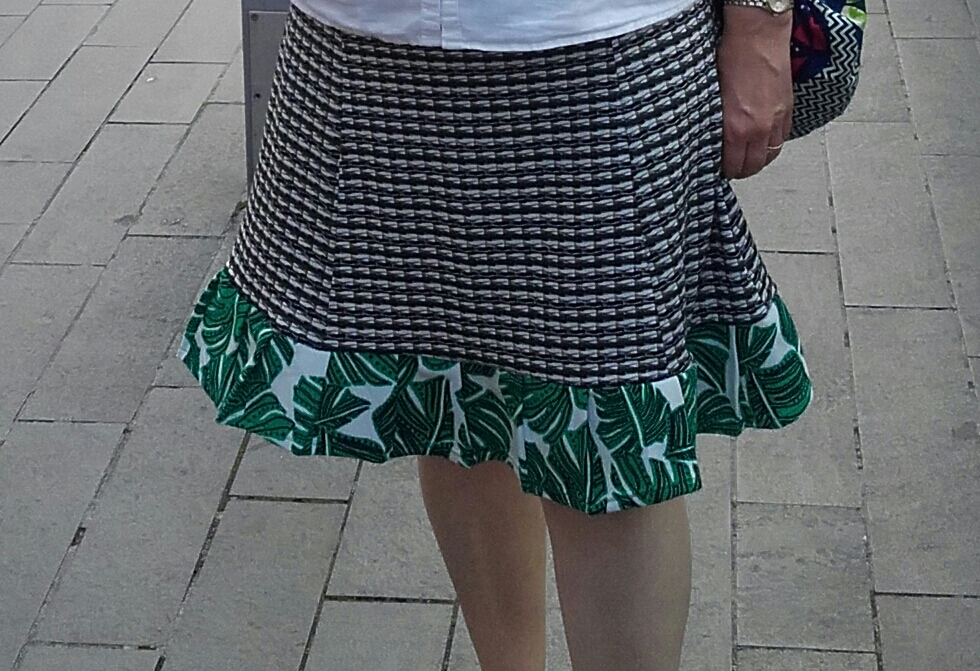
I made a skirt from a dress and a skirt given to me by the same person (my daughter)
Despite 2 different types of fabric, a thin stretchy jersey and a mid weight woven, they actually went together well. I had a penchant for a frill hem on a skirt at the time.
I didn’t actually make a waistband initially, just relying on the stretch in the fabric to hold the skirt up, but that didn’t really work and in 2020 I modified it with a waistband.
positives – very comfortable to wear due to the stretchy nature of the fabric
negatives – none really, its a summer season skirt
estimated number of wears – 25
I wore this skirt 10 times summer 2021 and have now discarded it.
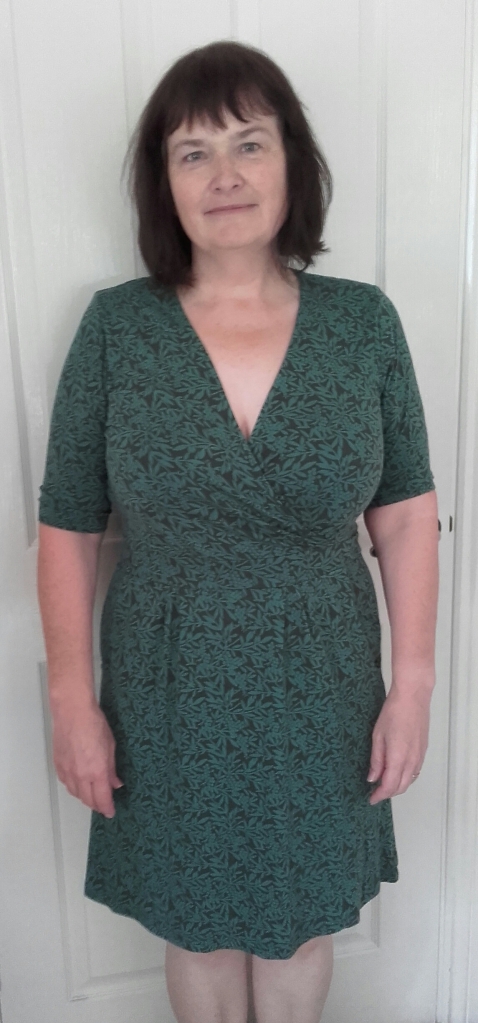
I was given this dress to refashion and I really liked the colour of the fabric, which had 2 way stretch.
The dress had a wrap top which in my experience always gape, so I cut off the wrap section and sewed a centre seam instead.
I used more of the dress fabric to add length under the wrap.
The trim around the neck V was the finishing touch. – see next photo for an image of the top.
Positives – good original fit around the shoulders and arms
negatives – can’t think of any
estimated number of wears – 20
I still have this top and it’s probably got another 20 wears in it, I have a lot of tops and they only get 10 wears per year.
Suit to skirt refashion – refashioners 2017
This refashioners challenge was indeed something of a challenge as I had never refashioned a suit before.
I think I chose a good ladies skirt suit to work with and gave it my best shot by making a panelled A line skirt from both the jacket and skirt elements of the suit.
The fabric was denim coloured but had a lot of stretch and an embossed finish.
Note that I used fabric from the previous refashion for a waistband.
This skirt grew on me and I ended up being quite a favourite ( it was easy to wear with any top)
positives – comfortable and goes with anything
negatives – the fabric was stiff and had no drape at all
estimated number of wears – 20
I discarded this skirt in Aug 2020, it wasn’t worn out and I was maybe just having a bad day.
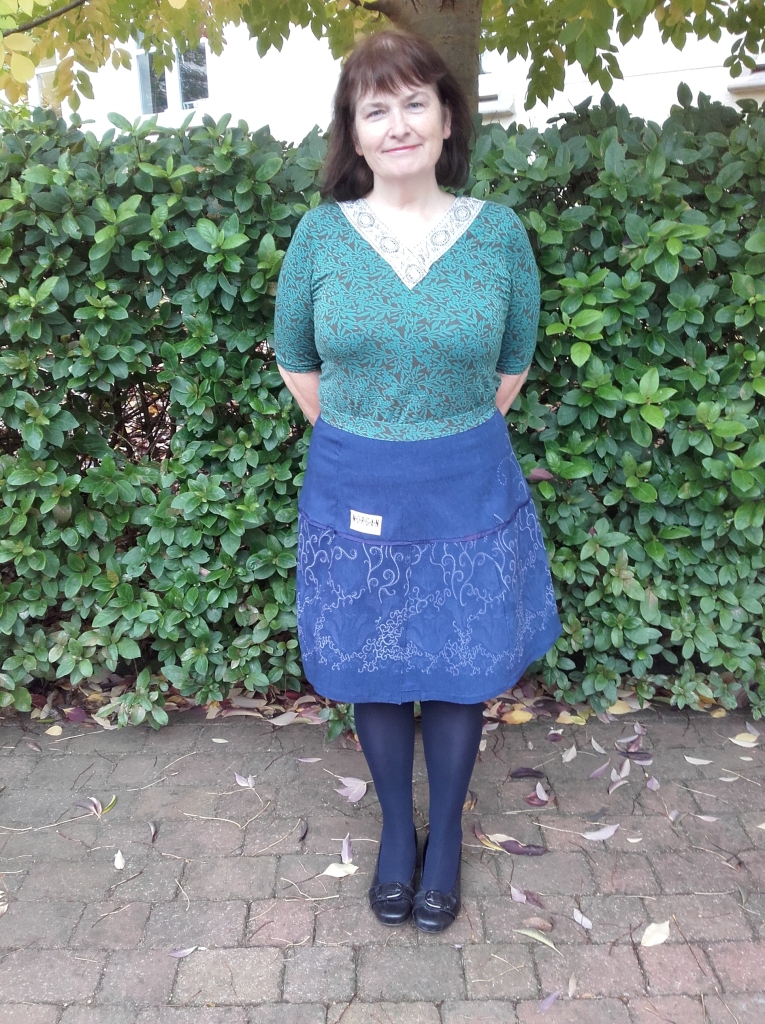
Skirt in 2017, worn with above top as a twofer.
This concludes my ‘sew wear are they now?’ series, I’ll leave it until next year to do 2018.
Vintage embroidered tablecloth to sunhat
I’ve got a small collection of vintage table linens, some are family items, some I purchased myself.
This one was made by my great aunt in 1950 or earlier.
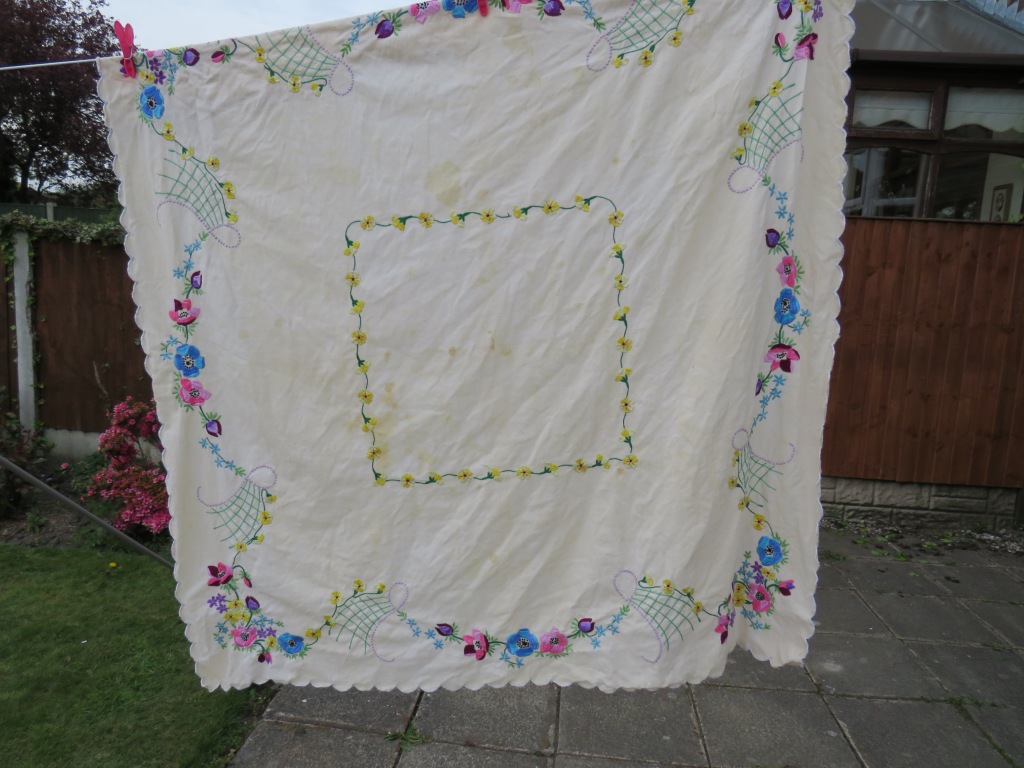
It’s beautifully bright and colourful, so perfectly embroidered, you can barely tell which is the back and which is the front.
The bright pinks, blues and yellows have been expertly stitched. The scalloped edge has been blanket stitched by hand, the base linen looks and feels silky like cream.
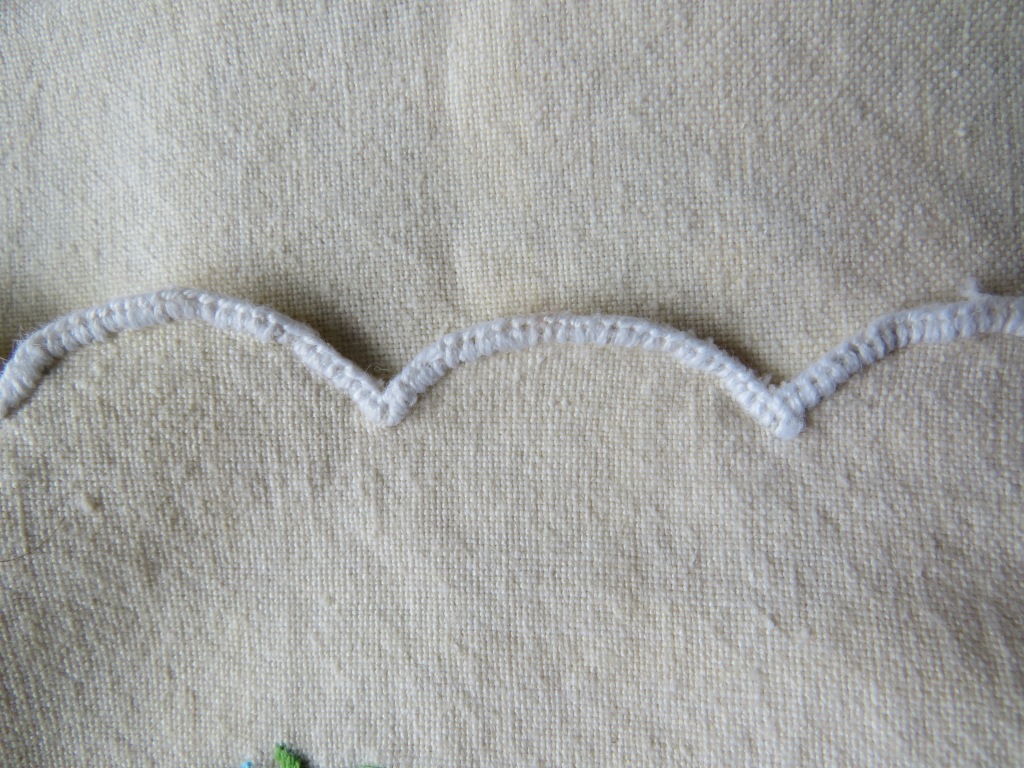
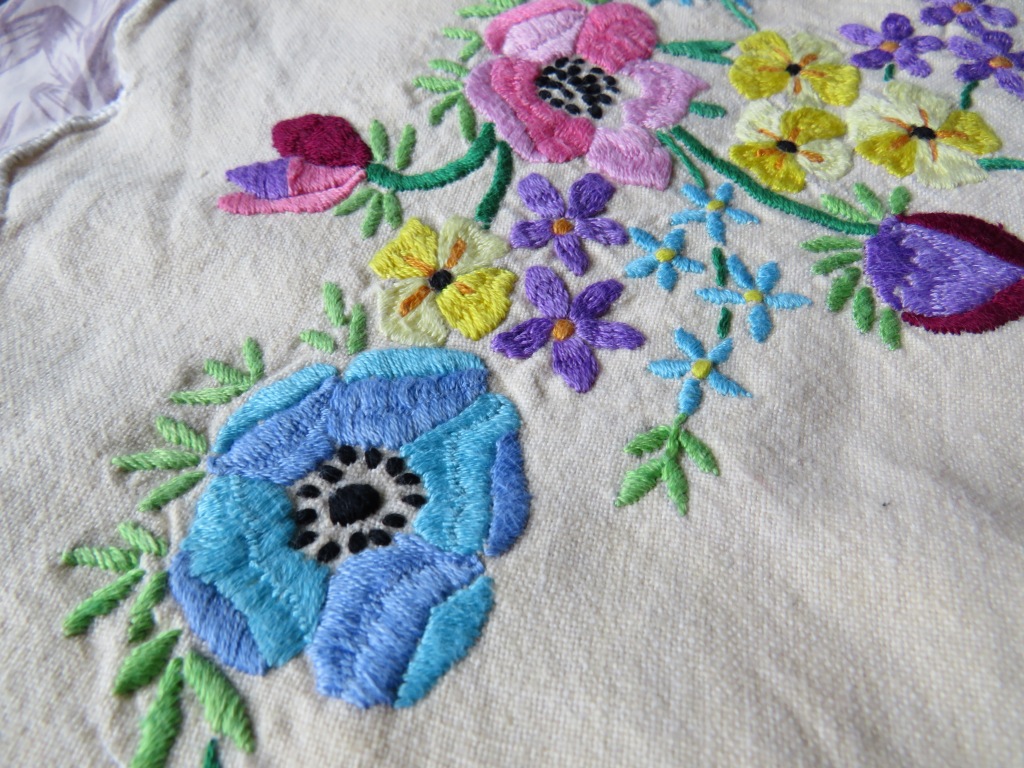
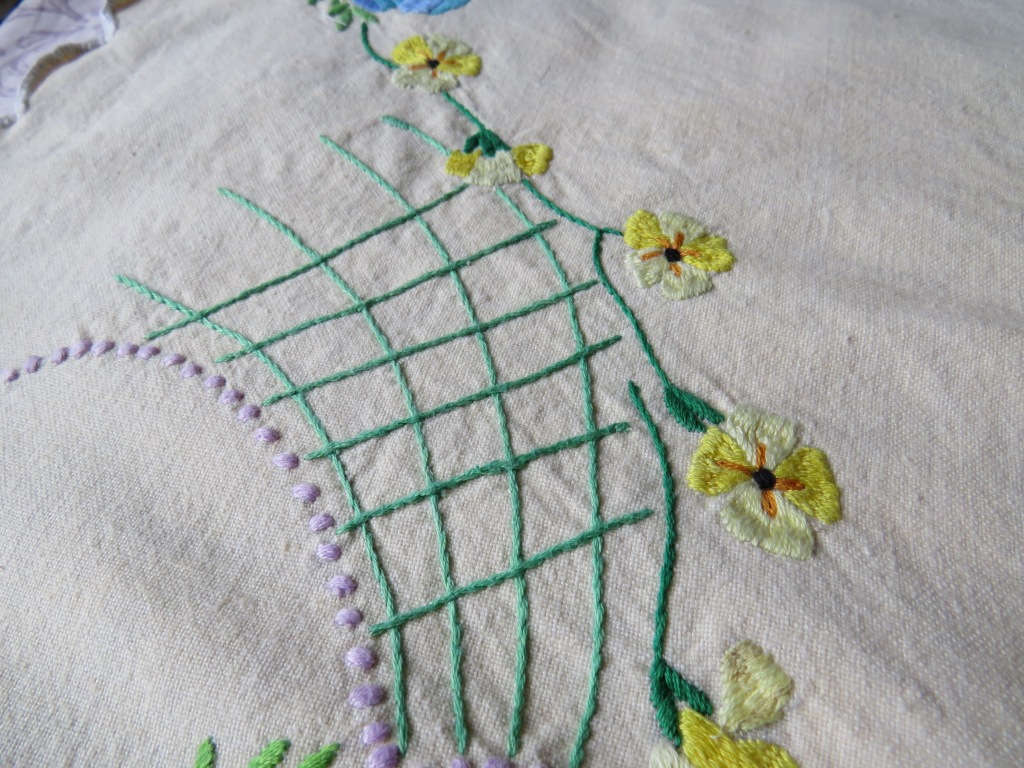
I’ve had it since 1993, the date of a different great aunt’s death and no one else wanted it. Its been in storage in a bag of mine and rarely seen the light of day in 28 years. Prior to that, I don’t ever remember seeing it in use and it was found in a suitcase under the bed, so this beautiful item has not been used and loved for 70 years.
There are stains, and I washed it in my machine on a delicate hand wash cycle, which did not damage the expertly stitched embroidery in any way but also did not remove the stains.
The reason it got washed this week was because there was a plan.
I find these pieces difficult to repurpose because there is not a lot of fabric to make a whole garment and the embroidery is delicate and positioned to suit a tablecloth not clothing.
I had purchased the Brighton bucket hat from sewgirl patterns
https://www.etsy.com/uk/shop/SewgirlintheUK
This hat has a small and large brim version and is reversible. I had already made a small brim version from a 2nd hand skirt and some vintage Laura Ashley homeware fabric:
It occurred to me that the size and curved shape of the brim pattern piece may fit the curve of embroidery typically sewn into the corner of a vintage tablecloth.
I cut my large brim hat pieces from the vintage tablecloth – fabric and pattern were a match made in heaven.
For the reverse I used a Orla Kiely curtain which had a similar background colour.
As both fabrics were mid weight I only interfaced one of the brim pieces – the instructions suggest more liberal use of interfacing.
What is great about the design of this hat is that the small brim version provides sun protection without being too large, and the large brim version is meant to be turned up so that the alternative fabric shows, and this showcases the flowery embroidery when the alternative fabric is outermost.
I am so pleased with both hats but especially with the large brim version because I have found a way to give the work of my talented ancestor a new life and a new set of viewers, both here online and in real life. A hat doesn’t need washing that often, doesn’t have areas of heavy wear and so should endure. The tablecloth maker died in 1959 so I never got to meet her, I suppose she never would have guessed that the youngest daughter of her husband’s niece would still be appreciating her work more than 60 years later. I am pretty sure none of my own sewing will stand that test of time.
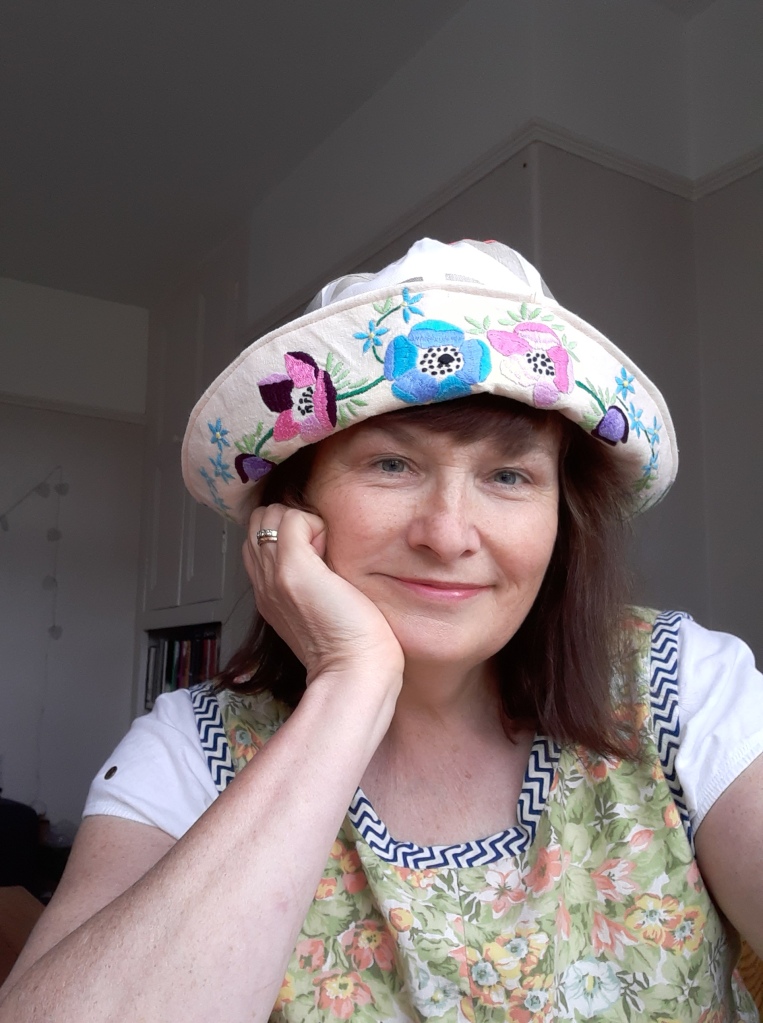
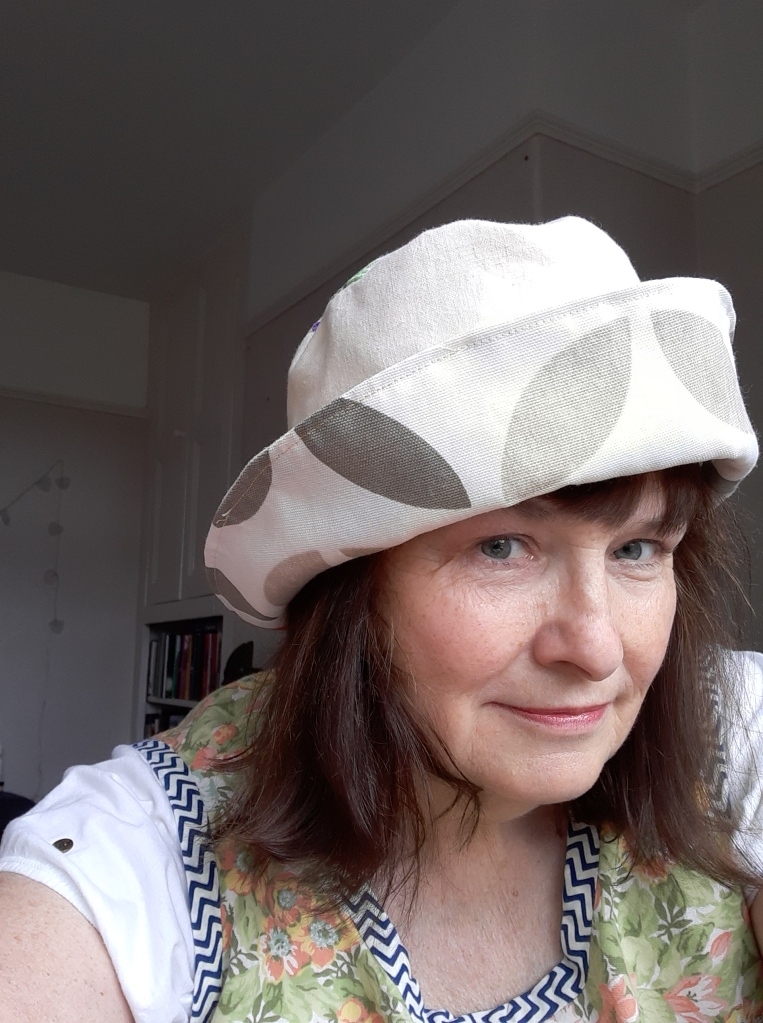
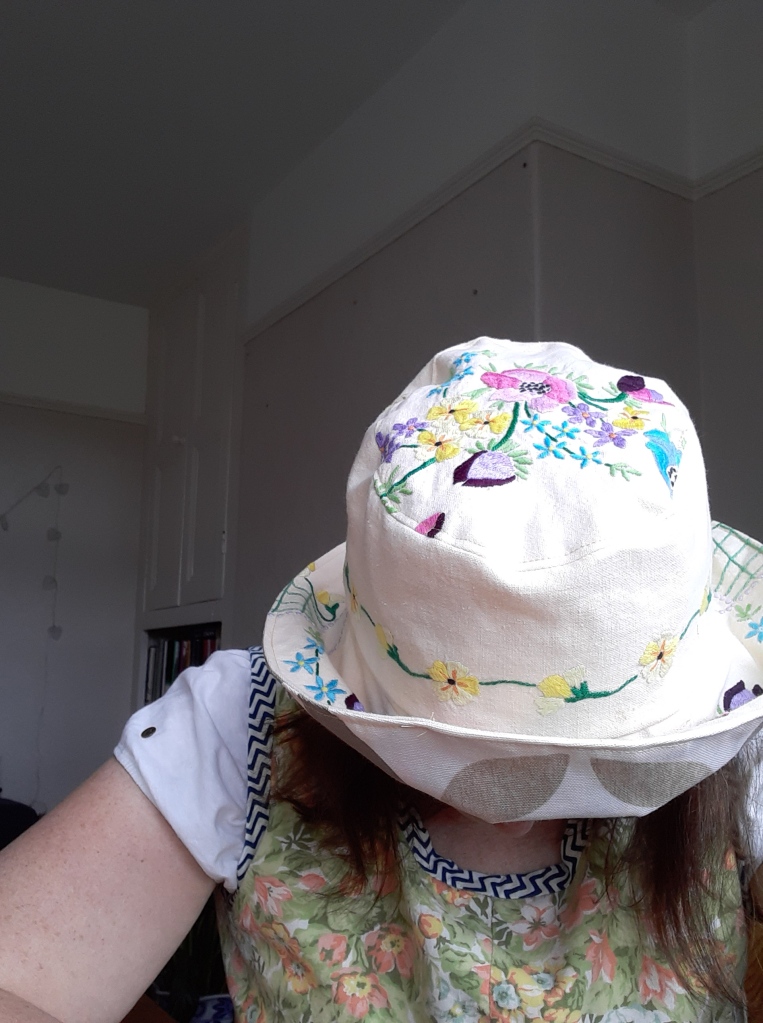
Sew wear are they now? 2016 edition – what happened to clothes I made in 2016
I made 17 things in 2016, 5 of which I still have. I won’t review all 17 just a representative selection.
There seem to be quite a number that didn’t go too well in 2016 so I will start with one of them
By way of explanation from 11.10.19 I started keeping records of how many times I wear clothes and refer to this in the post. I wear clothes in 10 wear blocks then put them away.
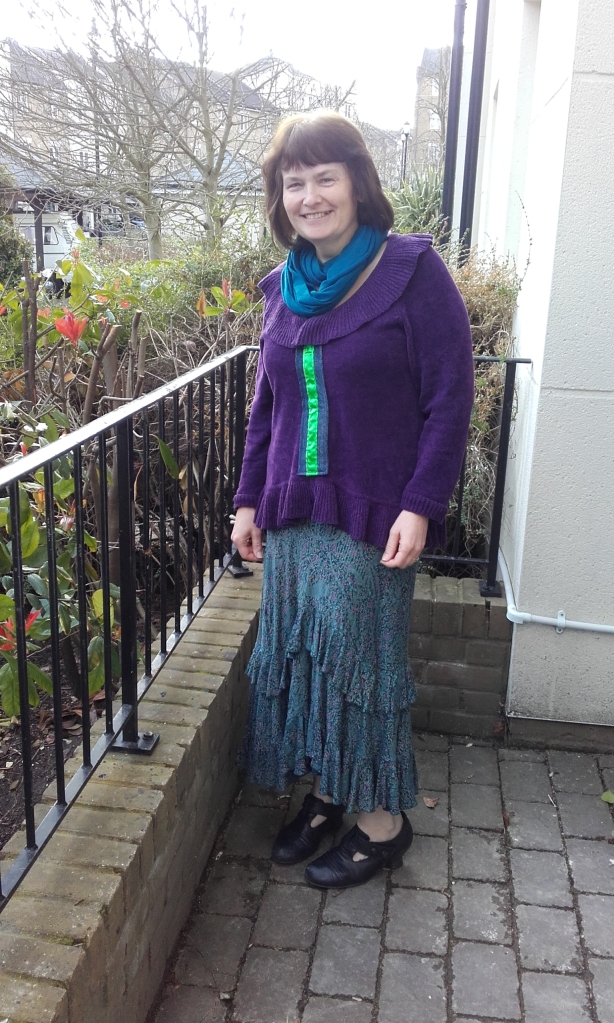
I took a waterfall chenille cardigan with frills on the cuff and hem as well, and turned it into a jumper with a fake button band. There were multiple problems with this refashion – the fake button band was too thick and looked too odd, the neckline was too low, it was too bulky to fit under a coat, and I just felt uncomfortable wearing it.
Positives – nice colour, cheap buy which was barely worn
Negatives – Impractical and uncomfortable to wear
Estimated number of wears – less than 5
I discarded this refashion at least 3 years ago, barely worn.
This was my entry for therefashioners 2016 the challenge was to make something out of used denim, the dress was modelled in 2016 by my daughter. I did these challenges for 3 consecutive years, each one pushed me out of my comfort zone but ended up with a result I was pleased with.
Positives – fits me perfectly and used denim is my favourite fabric.
Negatives – Can’t think of any
Estimated number of wears – 40 including 20 since 11.10.19
I still have this dress and but its probably only got 10 more wears in it.
22 inch waist scuba skirt to 2 hour top refashion
I made this top from a very small sized scuba skirt which had large pleats so contained enough fabric to make the front and back of a top. I used a free pattern https://sewdifferent.co.uk/2-hour-top-free-sewing-pattern-lc008/ so was ahead of my time as free patterns are very current in the sewing community!
I was just dipping my toes into the pattern world and although unable to complete the top in 2 hrs did find it a simple make. It was the first time I used scuba and it was a dream to sew. Some of the creases from its life as a skirt were very persistent, and it is a little sweaty to wear as the scuba was mid weight. My work lanyard made some little pulls in the front of the top as the lanyard had a sharpish corner to it.
Positives – simple design in plain fabric, wearable with many trousers and skirts
Negatives – a bit sweaty, some of the creases took a long time to disappear.
Estimated number of wears – 35, including 20 since 11.10.19
I still have this top and have worn it this week. It’s probably got another 10 or 20 wears left in it.
Auntie’s antimacassar to skirt refashion
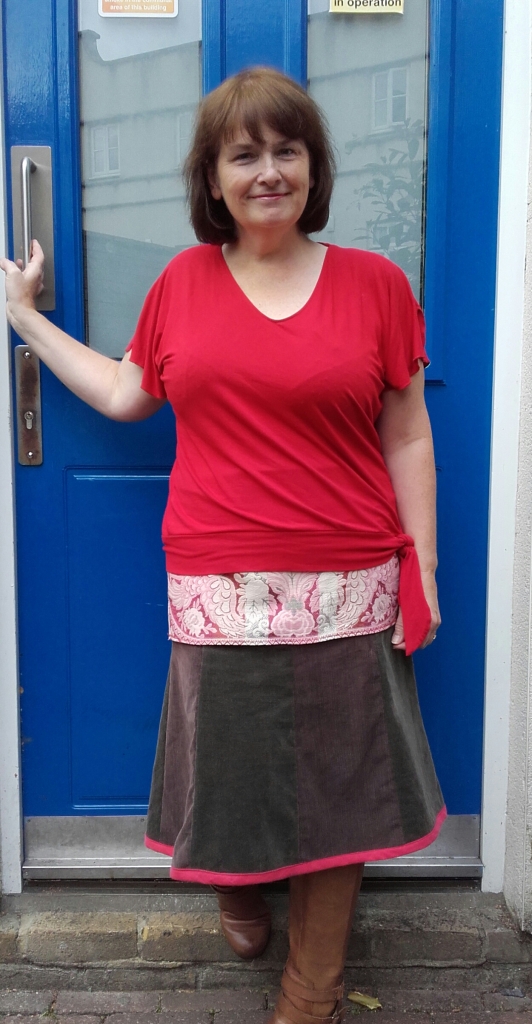
Out of many rather odd refashions I have done, this may be the oddest. I took a t-shirt, 2 pairs of cord trousers, a vintage antimacassar (damaged), a bit of old pillowcase, and made a skirt out of them.
It was actually comfortable and quite successful in that it got a reasonable amount of wear. The yoga waistband had to be made smaller as it tended to fall down and the antimacassar did not really tolerate washing.
Positives – I made an antimacassar into a skirt
Negatives – It was a bit odd
Estimated number of wears – 20
I discarded this skirt at least 3 years ago as the antimacassar was falling apart.
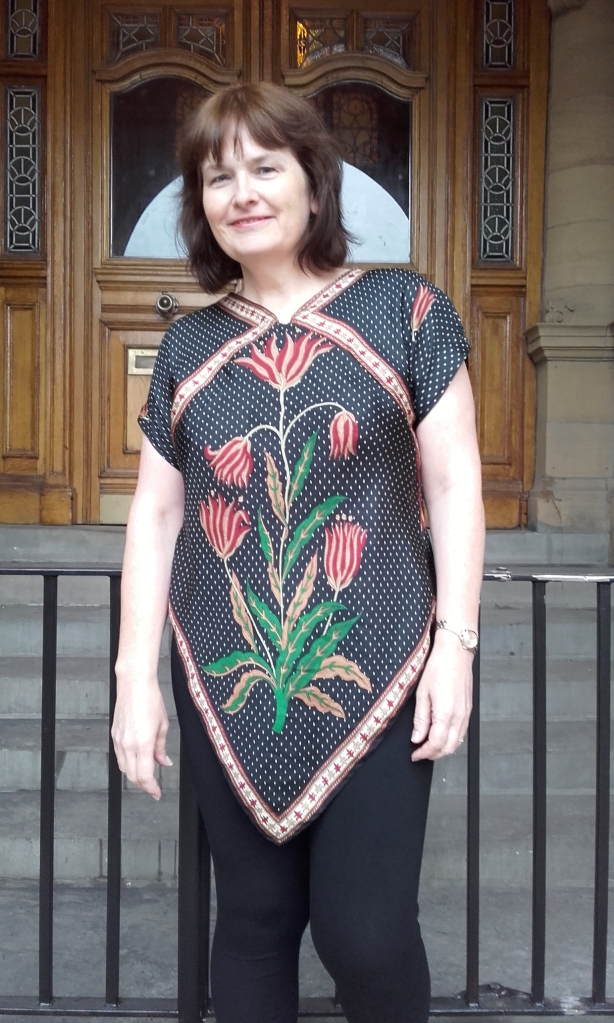
I made this top from a large scarf with a striking design, which I had found on the way to work.
I copied a tutorial found on pinterest (you can see details if you follow the link in the title) and though I had never heard the term at the time, it used an almost zero waste technique to make a top out of any scarf. This technique did involve sewing a bias cut, fray like hell, flimsy fabric so sweat and tears were involved in its making.
The top received many compliments when I was wearing it ( I was always a bit nervous wearing it to work in case someone claimed it as theirs)
The fabric was fragile and faded when (hand) washed, so after at most 20 wears it was looking scrappy under the armpits.
Positives – striking zero waste top
Negatives – scarves are not meant for this type of wear
Estimated number of wears – 15
I discarded this top at least 3 years ago as it was looking tatty.
This was a simple refashion where I took a nice but too small skirt and made it fit by increasing the waist size, this is a bit of a go to method for me as I have a 2 sizes difference between my waist and hip measurements.
I’m including this skirt because mostly because I still have it but to be honest am now a little bored with it.
Positives – good quality skirt
Negatives – I added quite a lot to the waist and if effects the drape and is still a bit tight.
Estimated number of wears – 25, including 10 since 11.10.19
I still have this skirt but its fate is 10 more wears this summer then out.
This concludes my review of 2016 makes, there are more of them back there in blog post history but I don’t want to labour the point.
Revisiting these older makes has brought me joy, 2017 to follow soon.
Siella McCalls 8085
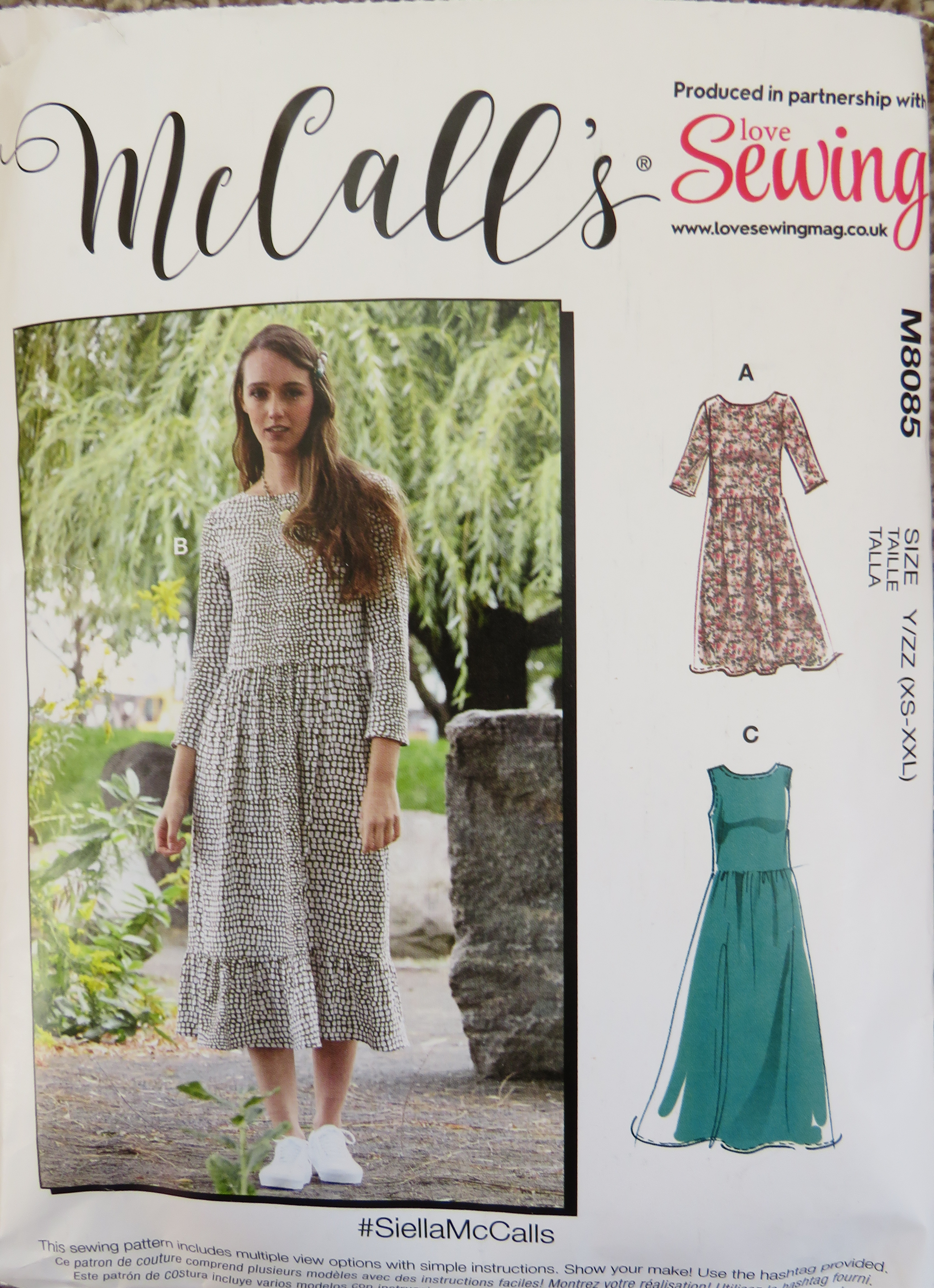
I got this pattern free with Love Sewing magazine and was surprised to find it was intended for knit fabric, as the design looks like a woven. (In fact many sewists have sized up and made it in woven). The fabric it has been made up in for the cover photo immediately reminded me of some fabric in my stash bought recently at
https://www.theclothshop.co.uk/
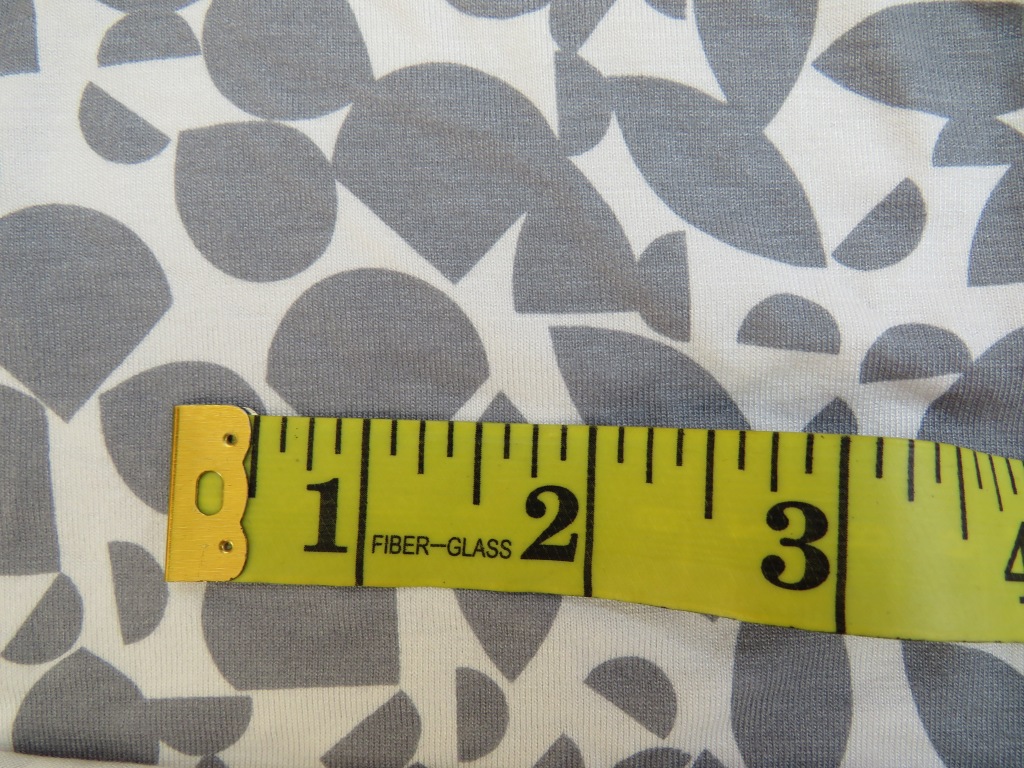
which is a viscose jersey with 4% lycra
I sewed view B
The pattern instructions are for a simple folded over boat neckline with no facings or binding but others who have sewed this suggested it could be improved by adjusting the neckline to add a bias facing. I agreed with this suggestion as I was worried the weight of the dress would pull the neckline down and also the neckline looked a bit high and would benefit from being lower.
I made other adjustments to the front bodice which were to raise the shoulder by 1cm as I don’t have much of a shoulder slope, and raise the armpit by 1cm accordingly. I took 1 inch out of the bodice length and cut the side seams of the front bodice a size larger as a sort of rudimentary FBA, so overall I cut a size M but for the bodice side seams I went to L.
Here is my adjusted front bodice piece.
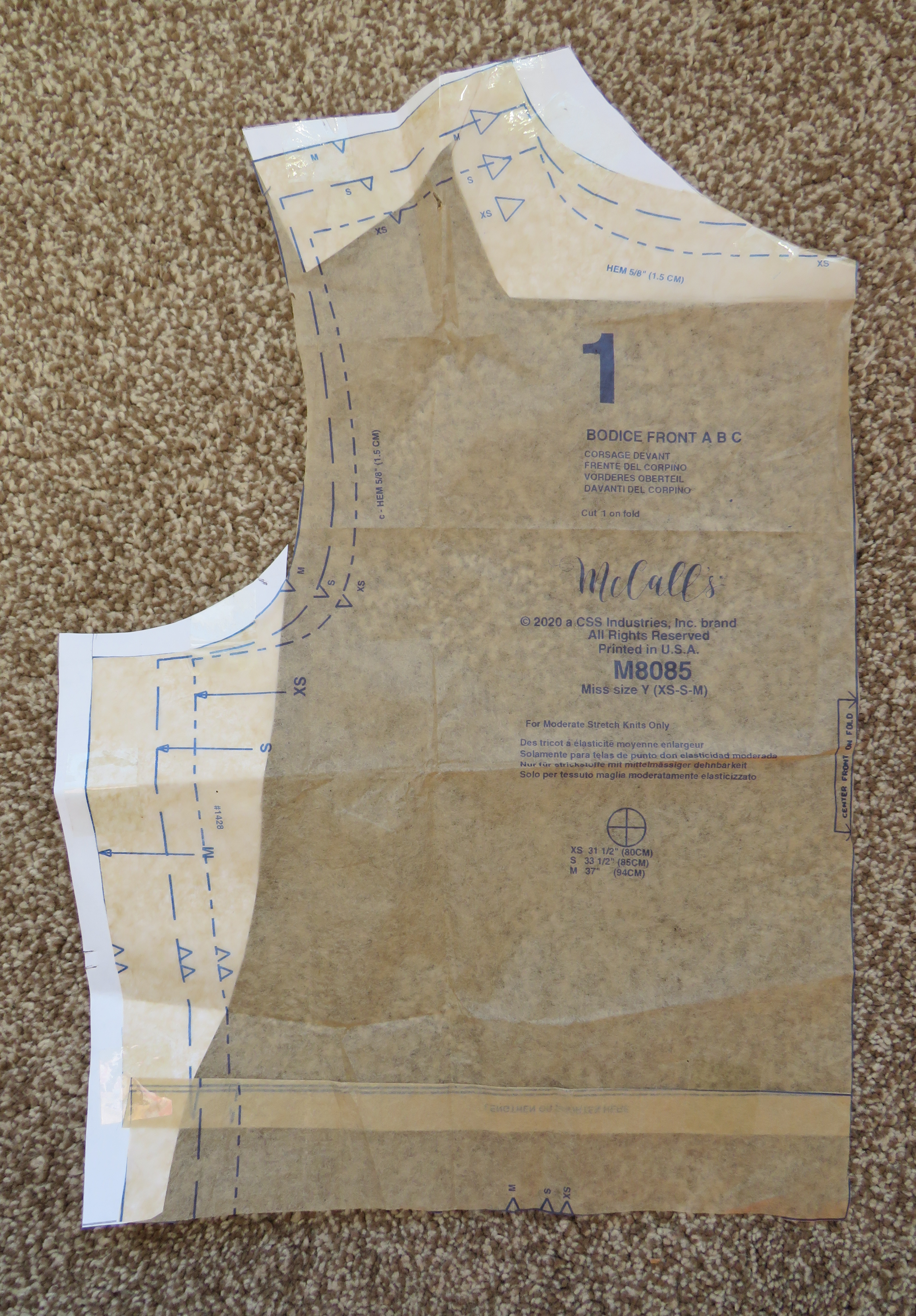
The dress looked quite long on the model so I took 2 inches off the main skirt piece and 1 inch off the ruffle and it still came up quite long on me.
Although not transparent, my fabric was quite thin so I cut 2 front bodice pieces exactly the same and sewed them wrong sides together as I have a RTW dress in similar fabric which is constructed like this. I then used the double layer as one piece, and this also helped to support the weight of the skirt better.
The pattern instructions suggest taping the shoulder seams and I taped the bodice side seams as well.
Construction was easy and straightforward, the skirt pieces are just rectangles, the trickiest part was the large areas of gathering and getting it even, which was needed time and patience.
The instructions suggested making an elastic casing from the seam allowances where the bodice attaches to the skirt but I was confused by this and missed it out. I already had extra bulk there due to by double layer bodice and the fabric is gathered and stretch anyway so didn’t understand the need for elastic. I can always add it later if the dress seems to need it.
When it came to binding the neckline I used normal home made cotton binding as a facing. I topstitched it down near the seam instead of under stitching (mistake) and then thought it would look awkward if I secured it with a second line of top stitching, so used one of my decorative stitches to secure the binding and am quite pleased with the result.
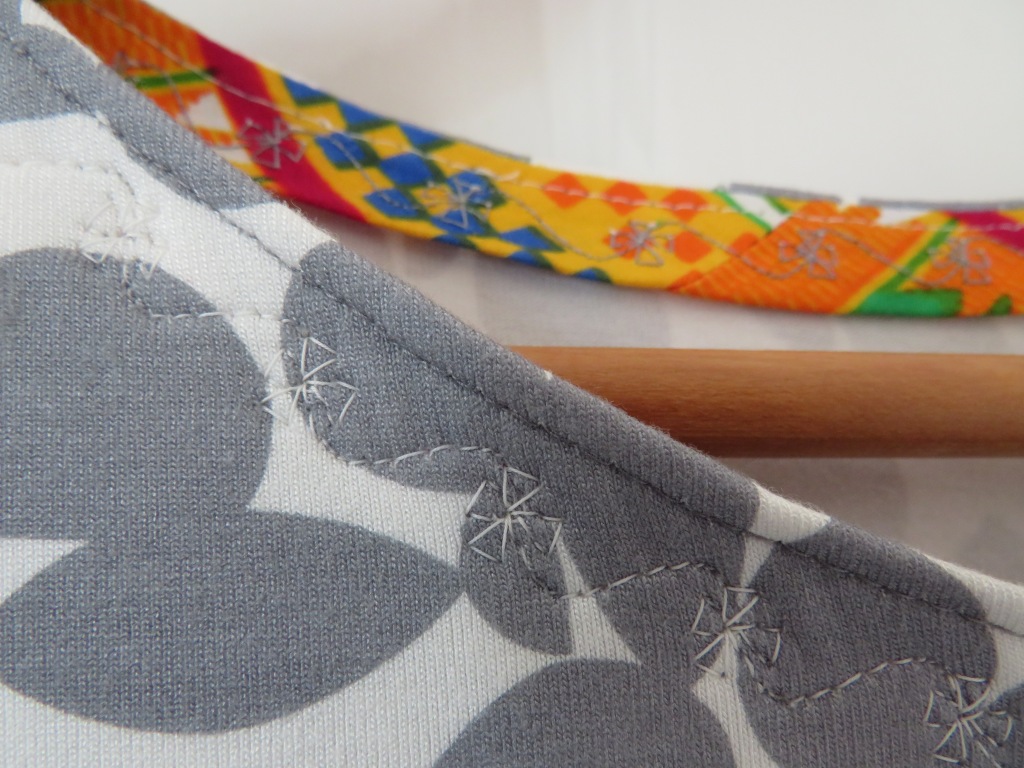
This dress has received many compliments. I am very pleased with it and would highly recommend this pattern. It’s easy, super comfy to wear, could be dressed up or down, has pockets, and is multi seasonal.
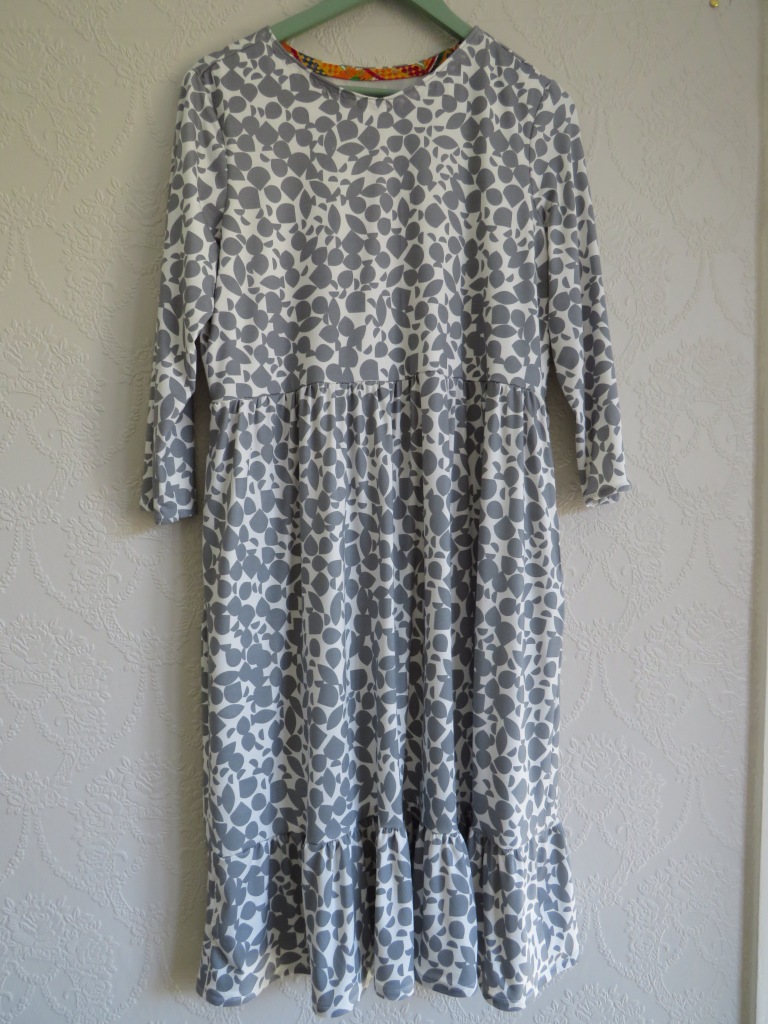
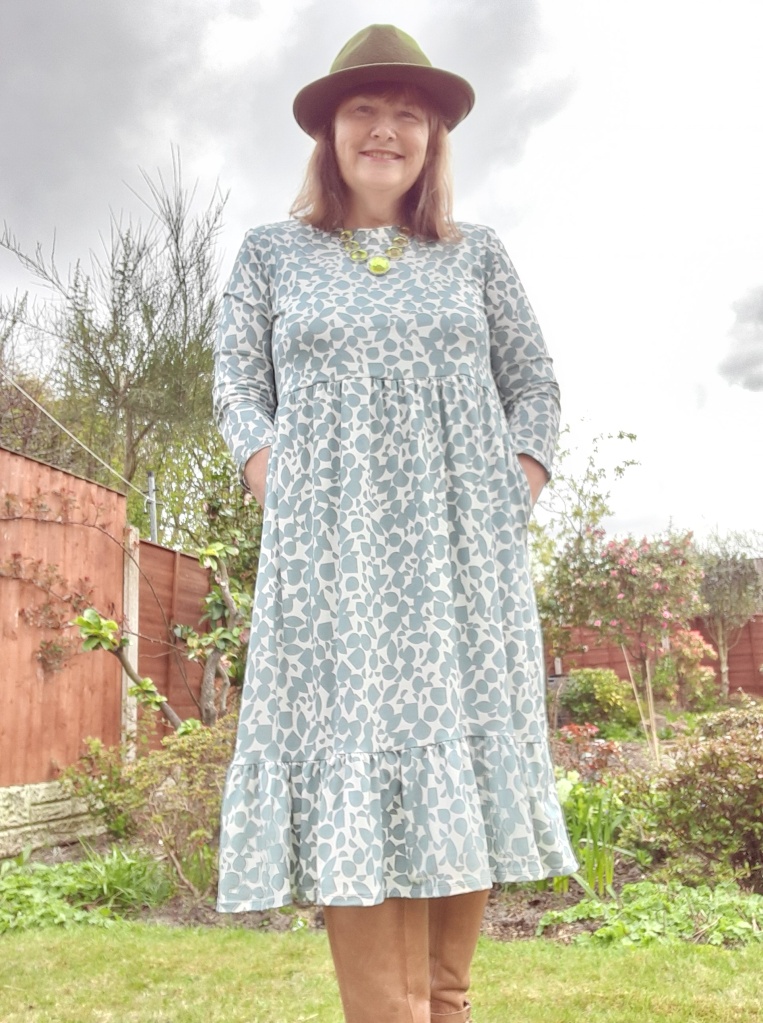
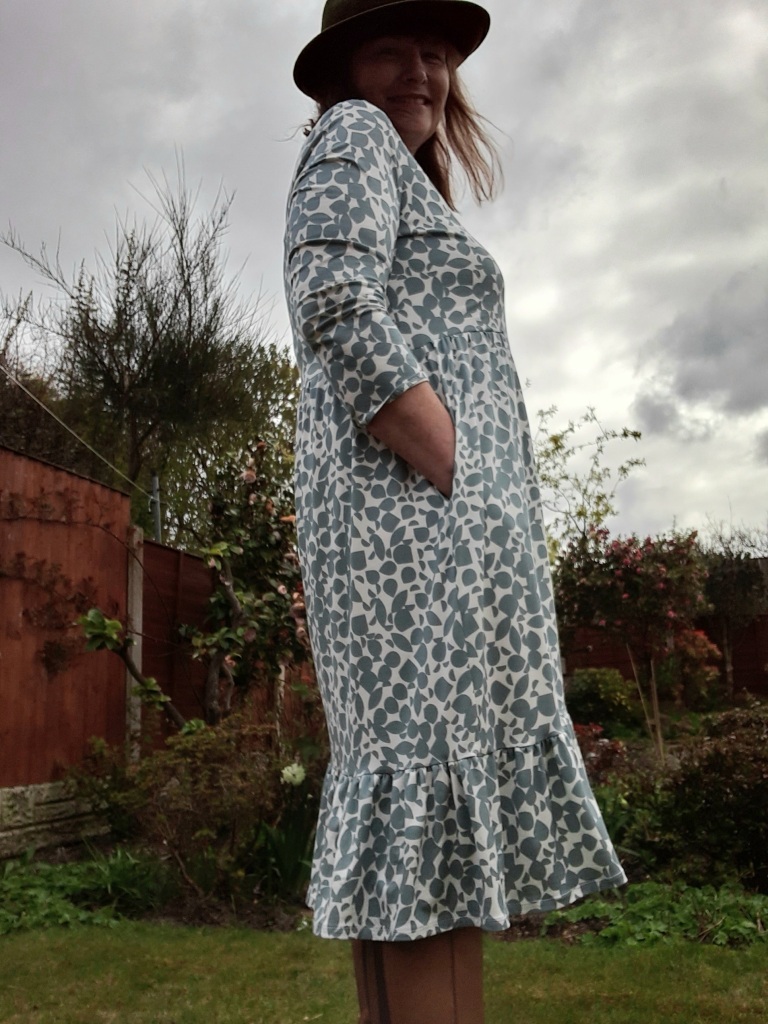
Sew wear are they now? 2015 edition – what happened to the things I sewed in 2015
Inspired by
I decided to look back on some of my older makes and reflect on their life history.
I started recording what clothes I wear on a daily basis from 11 Oct 2019 so prior to this date number of wears are estimates but after that they are accurate.
I bought a sewing machine in 2015 and it has changed my life…. well my wardrobe anyway.
I habitually bought second hand clothes at charity shops, so the first clothing items to be tackled were refashions.
I refashioned 13 items in 2015, 4 of which I still have, so here is the life history of some of my 2015 makes.
Dress and skirt to dress refashion:
The first item I ever blogged was this dress, the bodice of which was made from the skirt of a well worn RTW dress which I owned and the skirt was made from a drill type fabric 2nd hand skirt.
With this item I had beginners luck because the dress was a good fit, probably due to knit fabric on the top, and was comfortable to wear. It looks like a skirt and t-shirt but is more comfortable because there was no waistband. I loved the before dress and refashioned it because the armpits were getting a little grotty.
positives – comfortable and nice fit
negatives – weight of skirt tended to drag the bodice down a little
estimated number of wears – at least 20 in this re-incarnation and at least 20 as the before dress.
score 9 out of 10
I can’t remember when I discarded this dress but it must have been at least 3 years ago and the component parts had a final life as cleaning cloths in my home.
Shirt made bigger
This was my 2nd make and a found item which I noticed in a bin bag near my home, picking it out with the intention of using it as a fabric source. I actually ended up making the shirt fit me by sewing a rudimentary triangle into the back to make it bigger, the fabric for which came from shortening the shirt considerably. The reason I did this was because when I tried it on I was surprised how good a fit the shoulders and arms turned out to be. This shirt is something of a curiosity to me even now because the armholes are a perfect fit and I can lift my arms up and the body of the shirt does not move at all.
positives – perfect armhole fit
negatives – triangle on the back looks a bit odd and the side seams are thrown quite a bit forward as a result.
estimated number of wears – 20
score 5 out of 10 good fit but not many wears.
I have kept this shirt for sleeve fit reference and wore it 10 times in 2020 but then retired it from my wardrobe.
Party dress to gypsy skirt refashion
I bought a too small dress 2nd hand because I liked the fabric which was a mid weight cotton with some stretch. I made it into a skirt and added a denim ruffle at the hemline. I really enjoyed wearing this skirt because it was comfortable and had some structure.
positives – good design and fit
negatives – the fastening wasn’t very well done
estimated number of wears – 30
score 8 out of 10
I no longer have this skirt and threw it away at least 3 years ago as the fabric was pretty faded.
Club Tr Op icana t-shirt refashion
This is pretty typical of the refashions I was doing at the time. I bought a lightly worn t-shirt with a logo I didn’t like, lowered the neckline and created a pleated ruffle to cover it up. This refashion was pretty successful and got enough wears at the time
positives – fairly good design and fit
negatives – the neckline gaped a bit
estimated number of wears – 20
score 7 out of 10
I no longer have this t-shirt and threw it away at least 3 years ago as it was looking worn. It probably had a final life as a cleaning cloth.
Refashioners 2015 entry – alternative angles
Seen below in 2015 (on left) and now

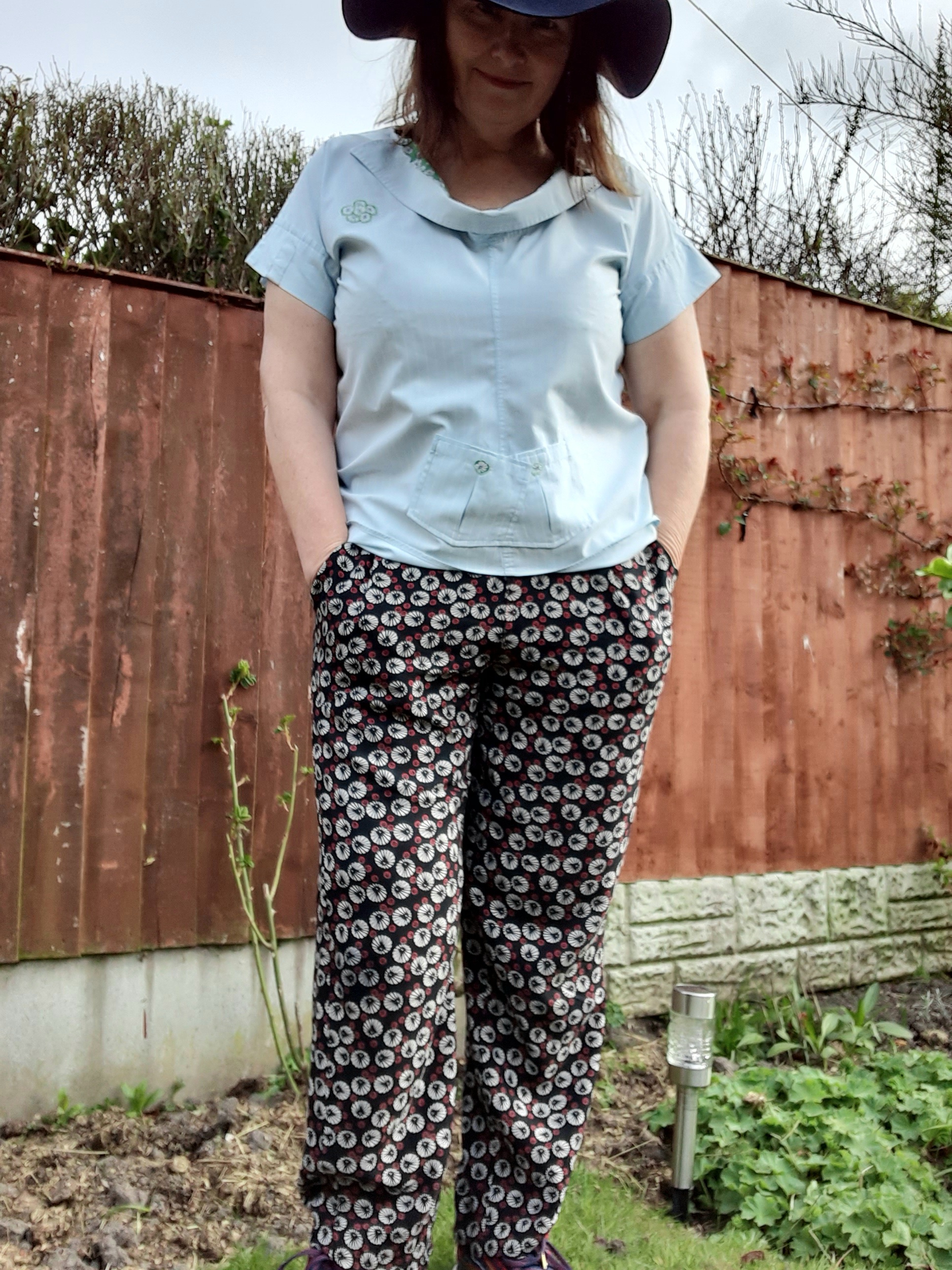
This shirt refashion was my entry for therefashioners challenge for 2015 which was to refashion a men’s button down shirt. I was, and still am, quite proud of my creativity in this make as I turned the shirt round 180 degrees so a former armhole became the neckline, and did the rest of the construction by draping, re-attaching the shirt collar with some added trim and re-positioning the pockets as one at the front. I could have probably done with a bigger sized shirt as this was a bit of a limitation. This top has a limited hot weather wearing season due to the low back but I do like it, and the pocket was useful on holidays for small items like tickets or credit cards.
positives – creative design
negatives – limited wearing season, its a bit snug on the bust
estimated number of wears – 15 including 5 in 2020
score 8 out of 10
I still have this top and intend to wear it some more this year. I will probably keep it long term as I am quite attached to it.
Keep your cloth as long as you can as long as you can shirt refashion
Don’t seen to have a 2015 photo of me wearing it so this is now:
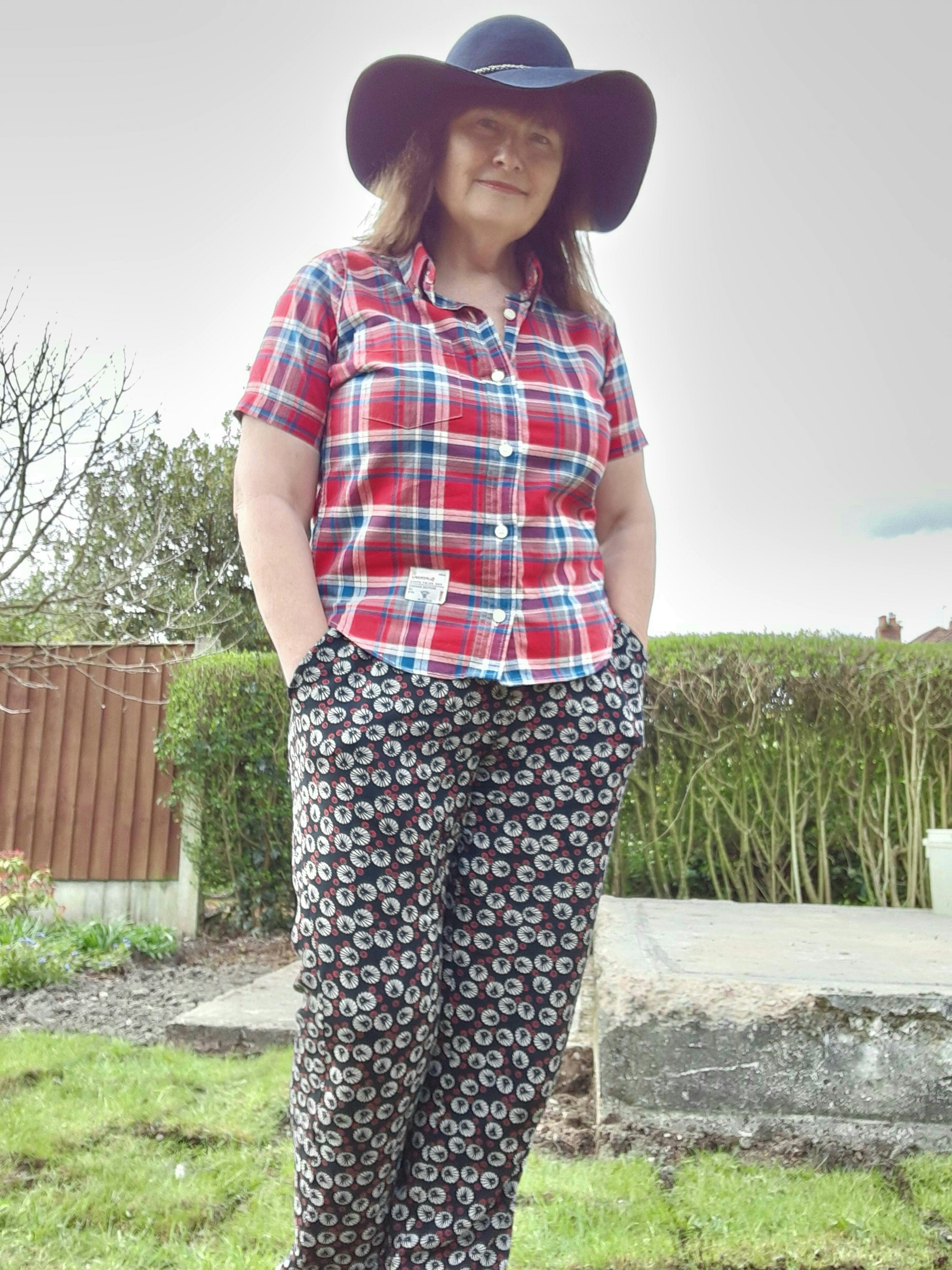
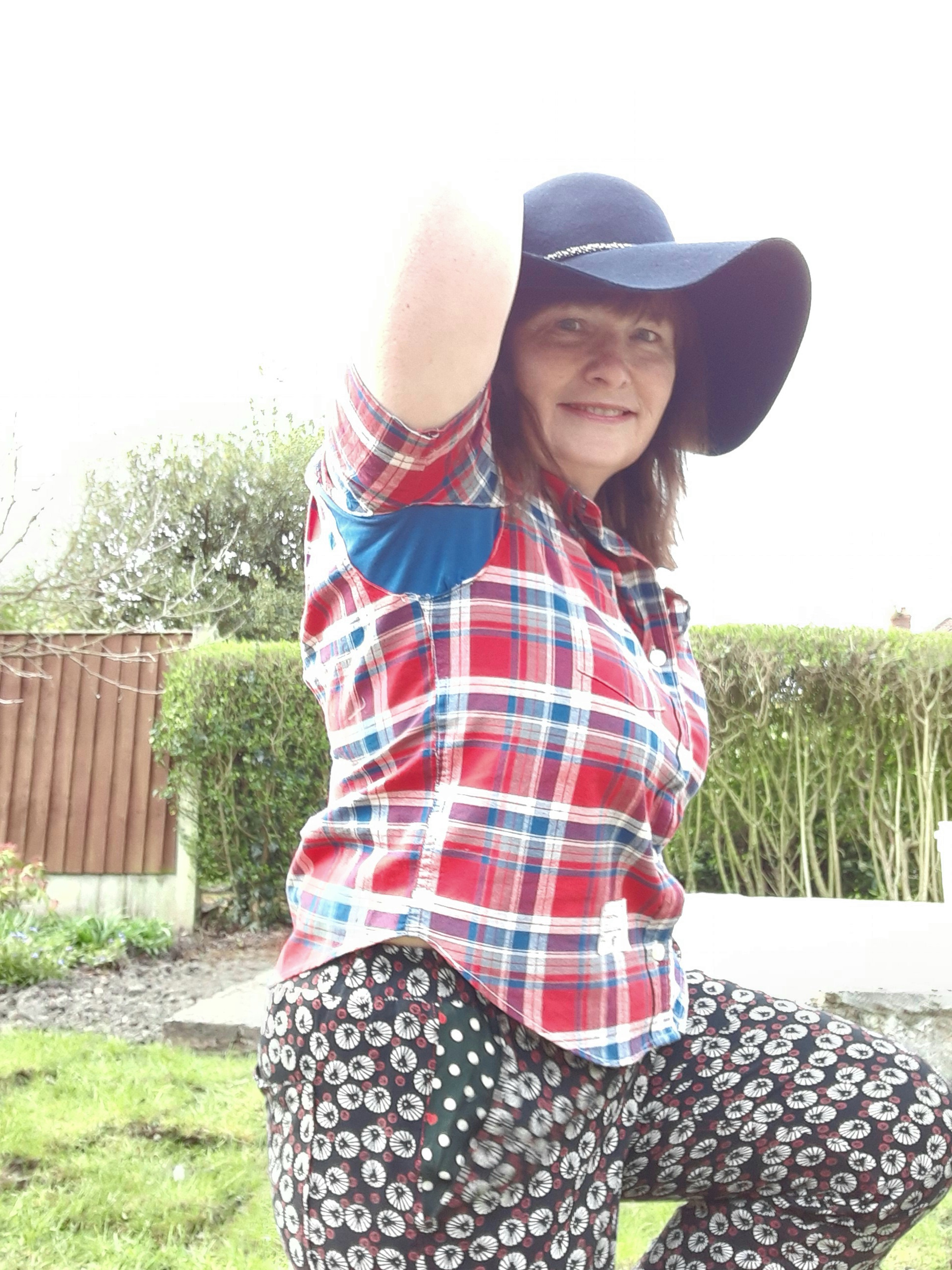
With no time to plan I bought this men’s shirt new for a particular event and paid £40 for it. It was too tight on the hips and too long, so after wearing for the event I decided to shorten it and make a shaped hemline.
I made a mistake and cut too much off the length. In addition poor armhole fit made the shirt ride up and expose my midriff, so I made a 2nd refashion of adding some knit fabric to the armpit area. This helped a bit but not enough. Having just tried this on again I am determined to bring it back into use as I now have more high waisted trousers and skirts it could be worn with comfortably.
positives – quality fabric
negatives – too short which limits wear
estimated wears – 10 but none since oct 2019
score – 2 out of 10
I still have this shirt as it was too good to throw out and did use the trimmed hemline piece for some other garment but can’t remember what now. I haven’t worn it for a long time but it will get 10 wears this year or my name’s not Helen.
That concludes my 2015 review. I haven’t included everything but a representative sample. The original blog post are still there if you wish to look. I used to favour making tops and so I am planning to target wearing some out this year. My records are showing me that most items will be looking quite worn after 40 wears and ready for retirement.

